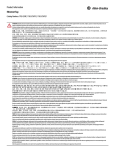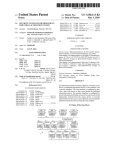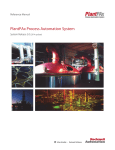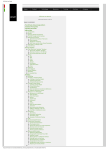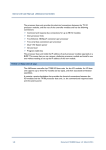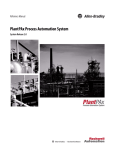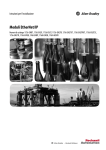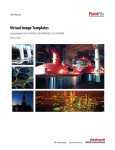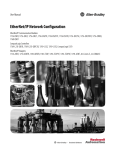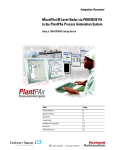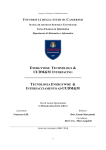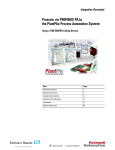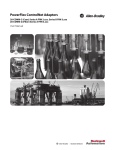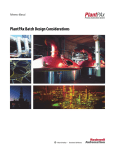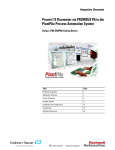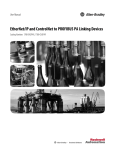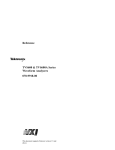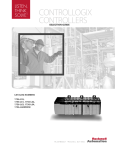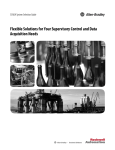Download proces-sg001 - Literature Library
Transcript
Selection Guide PlantPAx Process Automation System System Release 3.0 (2014 update) PlantPAx Process Automation System PlantPAx System Scope The PlantPAx® Process Automation System is a modern distributed control system (DCS). The system is built on a standards-based architecture by using Integrated Architecture™ components that enable multi-disciplined control and premier integration with the Rockwell Automation® intelligent motor control portfolio. Our scalable platform provides you with the flexibility to implement a system appropriate for your application. With the PlantPAx system, we prescribe a very specific system architecture with defined system elements, each with a specific responsibility and detailed specifications. Figure 1 -- PlantPAx System Implementation and Documentation Strategy Selection Guide Virtual Image Templates Quick Start Reference Manual Reference Manual Library of Process Objects Library of Logix Diagnostic Objects Library of Steam Table Instructions 46273 • • • • Define and Procure - Helps you understand the elements of PlantPAx to make sure you buy the proper components. Build - Provides direction on how to implement the PlantPAx server architecture to help develop your application. Prep - Provides guidance on how to get started and learn the best practices for developing your application. Develop Specific Application - Contains the application-specific libraries and objects that are used to construct your application that resides on the PlantPAx architecture. Purpose of Selection Guide This PlantPAx Selection Guide is designed to step you through the selection of system elements for creating a bill of materials for ordering your system. Using the prescribed architecture and recommendations explained in this manual, you can use the PlantPAx System Estimator (PSE) in a similar fashion to select a system when using the Integrated Architecture Builder (IAB) software. The PSE is part of the IAB tool. See page 12 for details. You do not need to read the sections in the order outlined on page 3. However, we do recommend that you start with the Overview to acquaint yourself with the system elements and architecture that comprise the PlantPAx system. 2 Rockwell Automation Publication PROCES-SG001G-EN-P - September 2014 Select a PlantPAx System Overview System Architectures Page 7 System Infrastructure Page 13 Servers and Workstations Page 19 EtherNet/IP™ Logix5575 RUN FORCE SD OK Controllers Page 39 Field Networks and I/O Page 43 Advanced Process Control Page 55 Process Safety Systems Page 59 Review: • PlantPAx system elements • System architectures • High Availability options • PlantPAx System Estimator • Software Release Information Select: • Virtualization • Domain controller • Network topology • Ethernet switches Select: • PASS server • Engineering workstation • Operator workstation • Independent workstation • Application servers • VMWare Component Sizing Select: • Simplex controllers • Redundant controllers • Skid-based controllers Select: • I/O product • Process network I/O • Field devices Select: • Regulatory control options • Supervisory control options Select: • ControlLogix SIL 2 systems • AADvance and Trusted SIL 2, SIL 3, and TMR systems • GuardLogix SIL systems • SIL-rated instruments • PowerFlex SIL 2 and SIL 3 Systems Rockwell Automation Publication PROCES-SG001G-EN-P - September 2014 3 Select a PlantPAx System What’s New? This revision of the PlantPAx Selection Guide updates system rules to support the latest characterized software versions and incorporates additional information on the following topics. Topic Description Page System infrastructure moved forward in manual The use of virtualization provides cost savings over traditional, physical servers. 13 Guidelines changed for server elements Added guidelines for when virtualization is used. 21, 23, 24, 25, 28, 31, 33 AppServ-OWS added to server section AppServ-OWS lets you host multiple thin clients as Operator Workstations from a single server. 25 AppServ-Info virtual image template added Added information on virtual image template for Historian server. 28 VMWare component resources and sizing listed VMware View and VMware vCenter solutions help you size, build, and manage your virtual platforms. 36 Intelligent motor control connections added Motor control solutions, including drives, soft starters, and relays, complement a variety of application requirements. 51 AADvance™ Control Systems section features additional resources Documentation explains the features, performance, and functionality of the AADvance controller and systems. 5, 61 PowerFlex® safety systems added to section SIL ratings listed for PowerFlex 525, 753, and 755 drives. 62 Additional Resources These documents contain additional information concerning related products from Rockwell Automation. Table 1 - Additional Resources Resource Description System Core PlantPAx System Application Templates Quick Start, publication PROCES-QS001 Describes how to configure controller and HMI templates to start development of your PlantPAx system. PlantPAx Hardware Specifications and Certifications, publication PROCES-SR027 Provides information on PlantPAx system hardware specifications and certifications. Knowledgebase Answer ID 62366 at http://www.rockwellautomation.com/knowledgebase/ PlantPAx Knowledgebase Table of Contents: Links to Rockwell Automation Library of Process Objects and associated documents for tips and best practices. ControlLogix System User Manual, publication 1756-UM001 Explains how to use tradition al and extreme environment ControlLogix® controllers. ControlLogix Selection Guide, publication 1756-SG001 Explains how to select a ControlLogix system based on your application requirements. CompactLogix Selection Guide, publication 1769-SG001 Explains how to select a CompactLogix™ system based on your application needs. Process Automation System Training Curriculum, publication PROCES-CA001A-EN-P Describes the courses that are available for a better understanding of the PlantPAx system. Redundant I/O System User Manual, publication 1715-UM001 Explains how to install and set up the 1715 Redundant I/O system. http://www.rockwellautomation.com/solutions/process Provides general information about Rockwell Automation process capabilities. From the left-hand menu on the home page, select DCS Migration Solutions for information on the DCS migration program. http://www.migratemyprocess.com/webinars Features prerecorded webinars on the DCS migration program and capabilities for process customers. Infrastructure Virtual Image Templates User Manual, publication 9528-UM001 Describes the catalog numbers and details for using virtual image templates for setting up virtual machines. PlantPAx Process Automation System Reference Manual, publication PROCES-RM001 Provides characterized recommendations for implementing your PlantPAx system. 4 Rockwell Automation Publication PROCES-SG001G-EN-P - September 2014 Select a PlantPAx System Table 1 - Additional Resources Resource Description Ethernet Design Considerations Reference Manual, publication ENET-RM002 Explains the infrastructure components that allow this open network to communicate seamlessly throughout a plant, from shop floor to top floor. Industrial Ethernet Media, Complete Solution for Ethernet Networks and Integrated Architecture, publication 1585-BR001 Provides information on Rockwell Automation 1585 Ethernet cables. Converged Plantwide Ethernet (CPwE) Design and Implementation Guide, publication ENET-TD001 Provides information on Ethernet security and firewalls. Product Compatibility and Download Center at http://www.rockwellautomation.com/rockwellautomation/support/pcdc.page Website helps you find product-related downloads including firmware, release notes, associated software, drivers, tools and utilities. Field Device Integration FLEX I/O and FLEX Ex Selection Guide, publication 1794-SG002 Explains how to select a distributed I/O system for safe and hazardous environments. POINT I/O Selection Guide, publication 1734-SG001 Explains how to select modular I/O modules for your system requirements. ArmorBlock® I/O Selection Guide, publication 1732-SG001 Explains how to select ArmorBlock I/O blocks that are suitable for On-Machine™ use. ArmorPOINT® I/O selection Guide, publication 1738-SG001 Explains how to select ArmorPOINT I/O modules. http://www.endress.com/eh/home.nsf/#products/~products-instruments List of instruments from Endress+Hauser Region Locations for Panduit Corporation, Product category Provides information on connected cabling systems and infrastructure management from Encompass™ partner Panduit Corporation. E+H Instruments via HART to PlantPAx User Manual, publication PROCES-UM002 Provides a step-by-step approach to integrating Endress+Hauser devices into a Rockwell Automation Integrated Architecture for Process Control system. Process Safety http://www.rockwellautomation.com/products/certification Complete list of ControlLogix products that are certified for SIL 1 and SIL 2 applications Using ControlLogix in SIL2 Applications Safety Reference Manual, publication 1756-RM001 ControlLogix components supported in SIL 2 configurations AADvance Solutions Handbook, publication ICSTT-RM447 Explains the features, performance, and functionality of the AADvance controller and systems. It sets out some guidelines on how to specify a system to meet your application requirements. AADvance System Build Manual, publication ICSTT-RM448 Provides experienced panel builders with information on how to assemble a system, switch on and validate the operation of a controller. AADvance Configuration Guide, publication ICSTT-RM405 Defines how to configure an AADvance controller by using the AADvance Workbench to meet your Safety Instrument Function (SIF) application requirements. AADvance Safety Manual, publication ICSTT-RM446 Defines mandatory standards and makes recommendations to safely apply AADvance controllers for a SIF application. Explains how to use tradition al and extreme environment ControlLogix controllers. AADvance Troubleshooting and Repair Manual, publication ICSTT-RM406 Provides plant maintenance personnel with information on how to trace and repair a fault in an AADvance system and perform routine maintenance tasks. You can view or download publications at http://www.rockwellautomation.com/literature. To order paper copies of technical documentation, contact your local Allen-Bradley distributor or Rockwell Automation sales representative. Rockwell Automation Publication PROCES-SG001G-EN-P - September 2014 5 Select a PlantPAx System Notes: 6 Rockwell Automation Publication PROCES-SG001G-EN-P - September 2014 Select a PlantPAx System System Architectures Welcome. and thank you for choosing the PlantPAx Process Automation System. The PlantPAx system is an integrated control and information solution that provides plantwide optimization in a wide range of industries. This single-platform system is built on open industry standards to help support seamless integration of the system components, as well as to provide connectivity to high level business systems. Review these options: • Process System Elements • PlantPAx System Architectures • High Availability Options • PlantPAx System Estimator • Software Release Information This section provides an overview on the system elements and architectures that comprise the PlantPAx system. Process System Elements To get started building your system, Table 2 summarizes the system elements. These elements (combinations of hardware and software products) are explained throughout this guide with corresponding catalog numbers to assist you with your equipment procurement. Table 2 - System Element Descriptions System Element Description Process Automation System Server (PASS) The PASS is a required system element that can host displays, alarms, and data connections to controllers. Multiple PASS servers can be used to provide additional system capacity or to create logical segregation of application content based on the process. See page 20 for guidance on how many PASS servers you need. Operator workstation (OWS) The OWS provides an interactive graphical interface to monitor and control the process. Engineering workstation (EWS) The EWS provides a central location for configuring the system and monitoring/maintaining system operation. AppServ-Asset management The asset management server acts as a centralized tool for managing automation-related asset information (both Rockwell Automation and third-party assets). The asset management application server includes capabilities for source control, audits, change notifications, calibration of instrumentation, reporting, and security. AppServ-Batch The batch application server provides comprehensive Batch Management, including unit supervision, recipe management, process management and material management. The batch application server can be linked with visualization elements at the OWS and configuration clients on the EWS. AppServ-Information management Information management servers store and manage manufacturing data as well as host decision support tools. Decision support tools include real-time reports, trends, and dashboards that publish key performance indicators (KPIs) through a web browser. Two options for the AppServ-Info server include Historian (see below) and decision support (VantagePoint) software. AppServ-Historian This base installation of the FactoryTalk® Historian server is configured via a virtual template. The server collects, manages, and analyzes real-time data from the PlantPAx system. AppServ-OWS The AppServ-OWS uses Microsoft Remote Desktop Services (RDS) technology to serve up to 10 instances of the OWS as thin clients from a single server. This provides for FactoryTalk View SE thin clients running applications and processing data on a remote computer to reduce the amount of information on a network. Controller The ControlLogix and CompactLogix controllers support continuous process and batch applications, including Advanced Process Control functions. These controllers also support discrete and motion applications. Independent workstation (IndWS) The independent workstation serves as a PASS, EWS, and OWS for single-station systems (independent class). Rockwell Automation Publication PROCES-SG001G-EN-P - September 2014 7 Select a PlantPAx System PlantPAx System Architectures Rockwell Automation characterizes the PlantPAx system based on its size or architecture class. A ‘characterized’ (system tested) classification yields system performance data and recommended hardware and software configurations. The classes of PlantPAx architecture offer system scalability while organizing Integrated Architecture products consistent with process industry expectations. The architecture classes shown below include the following: • System architecture with single station acting as PASS, OWS, and EWS • Distributed system architecture for single server with multiple OWS and EWS • Distributed system architecture for multiple servers and multiple OWS and EWS Distributed Architecture - Multiple PASS Servers Distributed Architecture - Single PASS Server Station Architecture Use these system elements in your process architecture. Table 3 - Architectures and System Elements System Element Station Architecture Distributed Architecture PASS Single computer serves as PASS, EWS, and OWS in an independent workstation One PASS required and includes the following: • FactoryTalk Directory server • HMI server • Data server • Alarms and Events Server Additional PASS as needed (up to 10 servers or redundant server pairs) EWS Included in independent workstation • 1 EWS required • Can have as many as 5 EWS OWS(1) Included in independent workstation Up to 10 remote clients per PASS; up to 50 for system Process controller(1) 1...5 ControlLogix controllers 1...8 ControlLogix controllers per PASS (data server) Application servers AppServ-Asset Management as needed AppServ-Batch as needed AppServ-Information Management (Historian or Reporting) as needed AppServ-Asset Management as needed AppServ-Batch as needed AppServ-Information Management (Historian or Reporting) as needed AppServ-OWS as needed (1) The actual number of OWS/controllers supported can vary based on controller selection, OWS configuration, and overall system loading. Use the PlantPAx System Estimator (PSE) to verify your system design. The PSE allows you to verify your application beyond these basic guidelines. 8 Rockwell Automation Publication PROCES-SG001G-EN-P - September 2014 Select a PlantPAx System PlantPAx System on an EtherNet/IP Network The PlantPAx system is built on open industry standards, leveraging the EtherNet/IP network as its backbone, to help support seamless integration of the system components, as well as to provide connectivity to higher-level business systems. The PlantPAx system supports the ControlNet or EtherNet/IP networks for device-level communication to deliver a business solution with real-time results from the plant floor to the top floor. EWS Domain Controller PASS Application Servers Multiple OWS Redundant Controllers Device-level Ring Topology Star Topology PlantPAx System on a ControlNet Network This diagram shows an example of the PlantPAx system architecture using the EtherNet/IP network for supervisory control and with I/O communication on the ControlNet network. The example is a distributed class for single or multiple PASS servers. EWS PASS Application Servers Domain Controller Multiple OWS EtherNet/IP Network Controller Redundant Controllers ControlNet Network H1 FOUNDATION Fieldbus Devices PROFIBUS PA Devices Rockwell Automation Publication PROCES-SG001G-EN-P - September 2014 9 Select a PlantPAx System High Availability Options In process automation, maintaining critical operations requires doing your engineering best to make sure nothing gets lost, stops working, or is damaged. This generally involves implementing a highly available automation system. The PlantPAx platform enables high availability by offering redundancy options at each level of the architecture. You can choose the level of redundancy you need without paying for redundant components you don’t need. Redundant Servers NIC teaming on servers and clients. Layer 3 with dual Ethernet fiber connections to Layer 2 fiber connections. For more information, see page 18. Crossload Media Redundant Controllers EtherNet/IP Device-level Ring Redundant I/O Modules 10 Rockwell Automation Publication PROCES-SG001G-EN-P - September 2014 Select a PlantPAx System High availability encompasses productivity, including reliability and maintainability. Reliability is the likelihood that a device performs its intended function during a specific period of time. Maintainability is the ability of a system to be changed or repaired. Table 4 - Redundant Element Options System Element High Availability Options Networks The following applies for Ethernet networks: • NIC teaming on servers and workstation uses two physical Ethernet cards on each server and workstation • Dual Ethernet media can connect the NIC cards to two separate level 2 switches. • Dual Ethernet fiber media can connect the level 2 switches to separate switches on a level 3 stack. • A Device-level Ring network can be used to connect the I/O racks and devices to your simplex or redundant controllers. The ControlNet network supports redundant media and adapters. For more information, see Network Topologies on page 14. Servers PASS servers can be configured as redundant for the following software components: • HMI server • Alarm & Event server • Data server The AppServ-Batch server supports different levels of fault tolerance. For more information, see Batch High Availability Options on page 35. The PlantPAx system supports off-the-shelf hardware high availability options for servers from our Encompass partner Marathon Technologies or through virtualization by using VMWare's ESXi architecture. Controllers ControlLogix controllers support enhanced redundancy on EtherNet/IP or ControlNet networks. For more information, see Redundant Controller Hardware Requirements on page 41. I/O modules The 1715 redundant I/O system offers redundant digital and analog I/O modules on EtherNet/IP or ControlNet networks. For more information, see Redundant I/O on page 44. Field devices Redundant process network interfaces are available for FOUNDATION Fieldbus and PROFIBUS PA networks. For more information, see FOUNDATION Fieldbus Devices on page 49 and PROFIBUS PA Devices on page 50. See the PlantPAx Reference Manual, publication PROCES-RM001, for additional redundant components and features, such as alarms and events. Rockwell Automation Publication PROCES-SG001G-EN-P - September 2014 11 Select a PlantPAx System PlantPAx System Estimator Rockwell Automation offers the PlantPAx System Estimator (PSE) as part of the Integrated Architecture Builder (IAB) tool. The PSE lets you define your PlantPAx system and verifies that your architecture and system elements are sized properly. The PSE creates a new workspace and opens a wizard (shown at right) to guide you through selecting system elements and sizing the system based on the rules and recommendations from PlantPAx system characterization. The following items are created based on your inputs: • Supervisory Ethernet network with all servers, operator, and engineering workstations and controller chassis • Listing of required software catalog numbers • ControlNet or Ethernet network for each controller that includes all I/O requirements • Various hardware views to support the various devices and chassis After selecting the system elements as defined in this guide, use the PSE tool to modify their properties to create a bill of material (BOM) in conjunction with the IAB tool. The BOM includes controllers, I/O, networks, drives, cabling and wiring, and other devices that comprise your Process Automation System. To access the IAB tool to use the PSE, see http://www.rockwellautomation.com/en/e-tools/configuration.html. Software Release Information The rules contained within this selection guide are based on using the following characterized software releases: • RSLogix™ 5000 software, version 20.x • FactoryTalk View software, version 8.0 • FactoryTalk Batch software, version 12.00 • FactoryTalk AssetCentre software, version 5.0 or later • FactoryTalk VantagePoint software, version 5.0 or later • FactoryTalk Historian software, version 4.0 or later Performance guidelines are based on the use of the software versions listed above. For new PlantPAx systems, we recommend that you use these versions of software. For the latest compatible software information, see the Product Compatibility and Download Center at http://www.rockwellautomation.com/rockwellautomation/support/pcdc.page. 12 Rockwell Automation Publication PROCES-SG001G-EN-P - September 2014 Select a PlantPAx System System Infrastructure In building infrastructure, you must decide whether your server and client workstations are in a virtual or traditional environment. Traditional, for our purposes, means one operating system (OS) that is natively on one computer. Virtual machines are hardware independent; not tied directly to a specific hardware or OS. Select from the following options: • Virtual Infrastructure • Traditional Infrastructure • Domain Controller • Network Topologies • Ethernet Switches This section describes the basics of the virtual platform, network topology, and Ethernet switches to help you select your system infrastructure. Virtual Infrastructure Virtualization breaks the dependency between operating system and physical hardware, allowing multiple virtual machines (VMs) to run different operating systems and applications from varying locations on the same server. This versatility helps to reduce footprint, consolidates hardware, and increases server utilization. You also can upgrade hardware without replacing the operating system on server or workstation system elements, thus reducing downtime and maintenance costs. If you are considering virtualization, you do not purchase specific server or workstation hardware for each system element being virtualized. You need the servers, storage, and network hardware only for your virtual infrastructure that hosts the system elements. Otherwise, your system elements are unchanged. We suggest that you visit the Rockwell Automation Network and Support Services website, http:/www.rockwellautomation.com/services/networks, for assistance. A VM behaves exactly like a physical computer because the VM contains its own ‘virtual’ CPU, RAM, hard disk drive, and network interface card. The VM runs as an isolated guest OS installation. The terms ‘host’ and ‘guest’ help distinguish the software that is running on the actual machine (host) and the software that is running on the VM (guest). The benefits of PlantPAx by using virtualization include increased energy savings, reduced system footprint and hardware cost, self-contained simulation and engineering, faster server provisioning, increased up time and availability, improved disaster recovery, isolated applications, and extended system life. Project teams can choose any hypervisor to run our virtual image templates. Flexibility and ease of deployment are key when designing a virtual infrastructure and both are an integral part of the PlantPAx system. If the project team needs guidance, Rockwell Automation has a partnership with industry-leading virtual infrastructure provider, VMWare, that provides step-by-step deployment guides for the PlantPAx system. When virtualizing your PlantPAx system, Rockwell Automation offers virtual image templates as an option to deploy the PlantPAx process automation system. The PlantPAx Virtual Image Templates deliver the core system elements as pre-configured, drop-in templates on a USB device. Virtual image templates are delivered in an open, virtual-format file and are officially supported and tested for use with VMWare vSphere. The pre-installed and pre-configured virtual image templates help to reduce validation costs and initial engineering time, simplify upgrades and patch management, and enhance scalability. Only one copy of the virtual image templates is needed for a project. Each server or workstation instance deployed from a template needs its own software licenses for the associated operating system and Rockwell Automation software. The PlantPAx templates are designed for use with Microsoft Volume Licensing. For more information, see the following: • Virtual Images Templates User Manual, publication 9528-UM001 -- Describes the PlantPAx virtual images for the deployment of the PlantPAx system on virtual architectures • PlantPAx Process Automation System Reference Manual, publication PROCES-RM001 -- Provides recommendations and guidelines for best practice of system architecture and elements Rockwell Automation Publication PROCES-SG001G-EN-P - September 2014 13 Select a PlantPAx System Table 5 - Virtual Image Templates Category Cat. No. Description Virtual templates 9528-PAXVTENE USB device that contains three virtual image templates (PASS, EWS, and OWS). Each template contains a Microsoft® Windows® operating system, with all required Rockwell Automation software pre-installed but not activated. A Microsoft full-packaged product license is included. 9528-APPOWSENE USB device that contains the virtual image template for AppServ-OWS. The template contains a Microsoft Windows operating system, with all required Rockwell Automation software pre-installed but not activated. A Microsoft full-packaged product license is included. IMPORTANT: Each client connecting to APPServ-OWS must have a valid client license. 9528-APPHISTENE USB device that contains the virtual image template for AppServ-Hist. The template contains a Microsoft Windows operating system, with all required Rockwell Automation software pre-installed but not activated. A Microsoft full-packaged product license is included. Traditional Infrastructure In a traditional infrastructure, each server and workstation is installed on its own physical machine. Software and hardware installations on individual computers require more time and maintenance than virtualized machines. In addition, system backups are more complicated and time-consuming than with a virtual environment. Thus, having the ability to run multiple VMs on one physical computer enhances the optimization of server and workstation physical assets. Network Topologies Industrial Ethernet systems require various infrastructure components to connect all the segments together. These include hubs, switches (especially managed switches), media converters, cables, and routers. It is recommended that managed switches be used throughout. Managed switches can be configured in several topologies. For more information on switches, see page 18. Table 6 - Supervisory Network Topology Description Star The traditional, most-common, EtherNet/IP network topology is a star, where end devices are connected and communicate with each other via a switch. In a star topology, nodes are typically grouped closely together. Advantages Disadvantages • Easy to design, configure, and implement • Loss of network service in case of a connection failure of a single component • Direct path between the infrastructure device and the end device • Remove and add devices without affecting the rest of the network • Primarily the single point of failure of the centralized switch • Increase port capacity on the switch to add more devices • Centralization can ease troubleshooting, because the switch sees the activities of all of the connected devices 14 Rockwell Automation Publication PROCES-SG001G-EN-P - September 2014 Select a PlantPAx System Table 6 - Supervisory Network Topology Description Redundant Star A redundant star topology is essentially where every Layer 2 access switch has dual connections to a Layer 3 distribution switch. Devices are connected to the Layer 2 switches. Advantages Disadvantages • Resiliency from multiple connection failures • Additional wiring and ports required • Faster convergence to connection loss • Additional configuration complexity • Consistent number of hops provide predictable and consistent performance • Fewer congestion problems Switch ring(1) A switch ring network is a single-fault tolerant ring network that connects Layer 2 switches to a Layer 3 distribution switch. Advantages Disadvantages • Ability to survive a single point of failure or a device being powered down on the ring • Additional configuration complexity • Simplified cabling • Variable number of hops can make performance difficult to predict • Ability to cover long distances by using fiber • Longer convergence times (1) Not characterized with the PlantPAx system, but a valid configuration. Additional Ethernet features that support high availability include these advanced network resiliency and convergence techniques: • EtherChannel and Link Aggregation Control Protocol (LACP) provide additional bandwidth between two devices by aggregating multiple Ethernet connections into a higher bandwidth virtual connection. These protocols quickly recover from the loss of one or more channel members. • Flex Links is a Cisco®-proprietary resiliency protocol that is for use in redundant star networks. This protocol connects an access switch to a distribution switch. Rockwell Automation Publication PROCES-SG001G-EN-P - September 2014 15 Select a PlantPAx System Table 7 - I/O Network Device-level ring (DLR) Recommended for control and I/O networks A DLR network is a single-fault tolerant ring network intended for the interconnection of automation devices. This topology has switches embedded into the end devices themselves; no additional switches are required. The DLR topology does require additional effort to implement and use as compared to a linear network. Advantages Disadvantages • Ability to survive a single point of failure or a device being powered down on the ring • Supervisor-node configuration required • Simplified cabling • Loss of network service in case of a connection failure of a single component • Ability to cover long distances with 100 m allowed between each copper segment • Very fast network convergence • Fiber segment can be up to 2 km by using an Etap (1F or 2F) • No required additional switch Linear network A linear network is a collection of devices that are daisy-chained together. The EtherNet/IP embedded switch technology allows this topology to be implemented at the device level. No additional switches are required. A linear topology works best for a limited number of nodes. Advantages Disadvantages • Easy to design, configure, and implement • Least amount of cabling • Loss of network service in case of a connection failure of a single component • Minimal amount of cable needed • Creates the potential for congestion problems • Ability to cover long distances with 100 m allowed between each link • Variable number of hops can make performance difficult to predict • Fiber segment can be up to 2 km by using an Etap (1F or 2F) • No required additional switch Star The Star is the most common EtherNet/IP network where devices are connected and communicate with each other via a switch. Nodes are typically grouped closely together. Advantages Disadvantages • East to design, configure and implement • Loss of network service in case of a connection failure of a single component • Direct path between the infrastructure device and the end device • Remove and add devices without affecting the rest of the network • Primarily the single point of failure of the centralized switch • Centralization can ease troubleshooting, because the switch sees the activities of all of the connected devices Redundant ControlNet media A ControlNet network supports the option of redundant media. For information on ControlNet media, see ControlNet Media System Components List, AG-PA002. ControlLogix Controller 1756-CN2R or 1756-CNBR Redundant ControlNet Media ControlNet Nodes 16 Advantages Disadvantages • ControlNet network supports a variety of topologies, including trunkline/dropline, star, tree, and ring • An additional network topology, cabling, and components for adding devices to the network • Deterministic, real-time control network that provides high-speed transport of both timecritical I/O and messaging data • No isolation for short-circuits in comparison to Ethernet network • New I/O modules are to be scheduled • Network unaffected by devices being connected or disconnected from the network Rockwell Automation Publication PROCES-SG001G-EN-P - September 2014 Select a PlantPAx System Domain Controller A domain controller is a server that responds to security authentication requests (logging in, checking permissions, and so forth) within the Windows server domain. A domain grants you access to a number of network resources (such as applications and printers) with the use of a single user name and password combination. PlantPAx uses a domain controller to store user account information, authenticate users, and enforce security policies. Domain authentication, whether it’s an existing domain or a new one, is recommended. Follow these guidelines for the domain controller: • A domain controller is required if there are 10 or more workstations or servers. • The domain controllers are separate computers. Do not load any application software on a domain controller. Load all system application software on the other computers, such as the PASS, application server, OWS, and EWS. • Microsoft support does not recommend running applications on a domain controller, and certainly not applications that require more than Authenticated User privileges to run. • The domain controllers must be local to the system workstations and servers (within the local firewall) and not remote to the system. • Domain servers must be configured to include Domain Name Service (DNS) that lets you identify devices by name rather than IP addresses. For redundancy purposes, we recommend that you use at least two domain controllers in the domain. These domain controllers replicate automatically to provide high availability and an online configuration backup. For more domain recommendations, see the PlantPAx Process Automation System Reference Manual, publication PROCES-RM001. Rockwell Automation Publication PROCES-SG001G-EN-P - September 2014 17 Select a PlantPAx System Ethernet Switches A network switch is a computer networking device that is used to connect devices on a computer network by performing a form of packet switching. A switch is considered more advanced than a hub because a switch sends a message only to the device that needs or requests it, rather than broadcasting the same message out of each of its ports. The collaboration of Rockwell Automation with Cisco on products, services, and educational resources, PlantPAx helps manufacturers and machine builders converge and simplify their network architecture and tightly integrate technical and business systems by using EtherNet/IP and industrial grade Ethernet switches. All applications require proper configuration to achieve the best system performance. If you do not configure the managed switch, it’s possible that system performance can be adversely affected. We recommend that you contact your system administrator if there are any doubts on the installation and configuration. Table 8 - Ethernet Switches If Then Recommended Media • Supervisory • Routing information to other networks Layer 3 switches • Stratix 8300™ • Cisco Catalyst 3560G or equivalent • Cisco Catalyst 3750x or equivalent • Cisco Catalyst 3850 Fiber(1) • Connecting control hardware, sensors, and workstations • Isolated networks Layer 2 switches • Stratix 8000™ • Stratix 6000™ • Stratix 5700™ • Cisco Catalyst 2960G or equivalent Layer 2/3 Services Router Stratix 5900™ Layer 2 Wireless Access Point/Workgroup Bridge Stratix 5100™ 1585-series copper media High availability at switch level Layer 3 switch • Cisco Catalyst 3750x or equivalent • Cisco Catalyst 3850 Fiber(1) (1) For uplink cables between Layer 2-3, fiber is recommended for 1 GB connectivity. 18 Rockwell Automation Publication PROCES-SG001G-EN-P - September 2014 Select a PlantPAx System Servers and Workstations The supervisory layer of the PlantPAx system can include Select from the following options: several servers and workstations. This section explains the • PASS Server following server and workstation system elements to help • Engineering Workstation (EWS) you define a bill-of-material. • Operator Workstation (OWS) • Operator Workstation Application Server (AppServ-OWS) • Independent Workstation (IndWS) • Information Management Application Server (AppServ-Info) PASS Server • AppServ-Info (Historian) • AppServ-Info (VantagePoint) The Process Automation System Server (PASS) is a required • Asset Management Server (AppServ-Asset) system element that hosts essential software components • Batch Management Server (AppServ-Batch) to run the system. The essential software components • VMware Component Requirements include the data server, HMI server, and alarm server. • Virtual Sizing Example You need to determine how many PASS servers are needed for your architecture. If your system requires more than one server, acquaint yourself with the following descriptions of the data, HMI, and alarm servers. See page 20 for illustrations. Software Components Description FactoryTalk Network Directory (FTD) server(1) Secures information from multiple Rockwell Automation software components across multiple computers and allows central administration throughout the PlantPAx system. In this way, application components, such as display and security settings, can be stored in their original environments and made available to the entire PlantPAx system without the need for duplication. See Process Automation System Server Software and Licenses on page 22 for licensing information. FactoryTalk View HMI server The human-machine interface (HMI) server is configured within your FactoryTalk View Site Edition (SE) application. The HMI server stores HMI project components, such as graphic displays, and serves these components to OWSs upon request. The HMI server also can manage tag databases and log historical data. Multiple HMI servers can exist on the PlantPAx system. FactoryTalk View Data server The Data server component provides access to information from the process controllers to servers and workstations on the PlantPAx system. FactoryTalk View software supports two types of data servers: Rockwell Automation Device servers (RSLinx® Enterprise software) and OPC Data servers. The Data server mentioned in PlantPAx documentation generally refers to the Rockwell Automation Device servers. Data servers are configured within your FactoryTalk View SE application. Multiple data servers can exist on the PlantPAx system. FactoryTalk View Alarms and Events server The Alarms and Events server publishes information from controllers and servers available to all subscribing OWSs. Alarms and Events servers are configured within your FactoryTalk View SE application. There are two types of Alarms and Events servers: device-based and server-based. Device-based Alarms and Events servers are configured as an option to the data server. The Server-based Alarms and Events servers are configured as a separate component. The Alarms and Events server mentioned in PlantPAx documentation refers to the Alarms and Events server that is server-based. (1) In redundant PASS configurations, this component is included on the primary PASS only. See PASS Redundancy Options on page 21 for more information. Rockwell Automation Publication PROCES-SG001G-EN-P - September 2014 19 Select a PlantPAx System Determining the Number of PASS Servers The following graphics illustrate how many servers are needed when you are not considering redundancy options. If you are using redundant servers, see page 21. Server Options Description Option 1 - One Server This option has all of the essential software components housed in a single PASS server: • FTD -- FactoryTalk Directory allows for central administration of multiple components that exist on multiple client servers. For example, security settings in original environments can be shared throughout the PlantPAx system. FTD Data server HMI server Alarm server • Data server-- The data server handles communication between controllers and the servers and workstations. Data servers are limited by capacity, such as number of OWSs, communication of controllers to displays, and communication of controllers to data logs or Historian software. 46194 • HMI server-- These servers segregate the plant into logical areas; also store visualization components for OWS upon request. • Alarm server -- When the PASS is used as a data server, it is also typically used as an alarm server. One HMI server license is required. Option 2 - One Server with Additional Data Capacity Required (1) Data server Alarm server FTD Data server HMI server Alarm server 46195 This option contains all of the software components in one server as shown in Option 1, plus an additional server for extra data and alarm capacity without adding an additional HMI server. If the PASS server is being used as a data server, and additional capacity is needed, you can add more PASS servers. Use the PSE to determine if more PASS servers are needed. A PASS server can typically handle 1…8 controllers. We recommend that you have an HMI server on the PASS if you are segregating the application into individual operational areas. See Option 3. One HMI server license is required. Option 3 - Logically Segregated Plant into Operational Areas This option lets you configure separate areas, each one with its own server that is based on the particular process. Data server HMI server An HMI server license is required for each PASS. Alarm server FTD Data server HMI server Alarm server 46196 Option 4 - Logically Segregated Plant into Operational Areas (fully independent) Data server HMI server Alarm server Data server HMI server Alarm server FTD You can place the FTD on its own server to manage applications that exist on multiple client servers. If an area needs to be shutdown, the other separate areas are not affected because the FTD is on its own server. For example, you can perform maintenance on one area without affecting another operational area of the plant. FTD can be a workstation class machine. An HMI server license is required for each PASS containing an HMI server. 46197 (1) Not characterized with the PlantPAx system, but a valid configuration. 20 Rockwell Automation Publication PROCES-SG001G-EN-P - September 2014 Select a PlantPAx System PASS Redundancy Options PASS servers can be configured as redundant for the following software components: • HMI server • Alarm server • Data server Redundancy can be added to be sure of the availability of critical operations. For PASS servers, you can choose the level of redundancy that you need. When a PASS is made redundant, typically all of the above elements that are hosted on the PASS are made redundant. Redundant PASS servers require duplicate hardware as listed in Table 9.1. Selecting redundant data servers impacts controller memory and communication bandwidth. For more information, see the following: • High Availability Options on page 10 • PlantPAx Process Automation System Reference Manual, publication PROCES-RM001 Table 9.1 - PASS Virtual Requirements Category Requirement(1) Virtual infrastructure Required: • 2 vCPU • 4 GB vRAM min Recommended CPU and memory allocation: • High priority Resource pool(2) Recommended hard drive sizing averages:(3) • 40 input/output operations per second (IOPS) • 35 reads/sec • 5 writes/sec Operating system Windows 2008 R2 SP1 operating system, 64-bit (includes Microsoft Internet IIS with WWW service) Additional third-party software Antivirus software(4) (1) (2) (3) (4) All numbers and figures are referenced for initial sizing only. Actual performance can vary in final implementation. See the PlantPAx Reference Manual, publication PROCES-RM001, for Resource Pool Allocation. Check with your drive manufacturer for specifics. Manufacturers provide drives with varying amount of capacity at each speed. Rockwell Automation has tested the use of Symantec Endpoint Protection. For more information, see Knowledgebase Answer ID 35330 at https://www.rockwellautomation.custhelp.com. Table 9.2 - Pass Traditional Requirements Category Requirement Traditional infrastructure The PASS must be installed on server-class hardware. The following are sample specifications based on PlantPAx system characterization: • Intel® Xeon Multicore processor (4 cores or greater) • 2.40 GHz CPU • 4 GB RAM min • Dual hard drives (one for application code; one for logging if data logging is used or for historian data collection buffering if historian is used) • Ethernet card that supports redundant media if NIC-teaming is used (If you plan to use a motherboard-NIC make sure it supports redundant media) Operating system Windows 2008 R2 SP1 operating system, 64-bit (includes Microsoft Internet IIS with WWW service) Additional third-party software Antivirus software(1) (1) Rockwell Automation has tested the use of Symantec Endpoint Protection. For more information, see Knowledgebase Answer ID 35330 at https://www.rockwellautomation.custhelp.com. Rockwell Automation Publication PROCES-SG001G-EN-P - September 2014 21 Select a PlantPAx System The PASS requires that you purchase visualization software licenses depending on the number of displays hosted by the PASS server. If the PASS server is not being used as an HMI server, then no license purchase is required. Make sure to account for process displays, faceplates, navigation devices, and so forth, in your display count. For example, the Rockwell Automation Library of Process Objects includes more than 100 faceplates, help displays, and quick displays. If all of the library objects are loaded into your application, these faceplates and help files count against your display count license. Table 9.3 - Process Automation System Server Software and Licenses Category Cat. No. Description Virtual image template One copy per project if using virtualization and virtual image templates: 9528-PAXVTENE USB device contains a virtual image template that has pre-installed all applications that are required on the PASS. Rockwell Automation software licenses Select one of the following per PASS when the PASS is used as an HMI server:(1) • 9528-PASS100ENE • 9528-PASS250ENE • 9528-PASSUNLENE Number of displays: • 100-display license for the PASS server • 250-display license for the PASS server • Unlimited display license for the PASS server (1) These PASS software licenses are equivalent to FactoryTalk View SE server licenses: 9701-VWSS000LENE, 9701-VWSS250LENE, 9701-VWSS100LENE. You can use either the PlantPAx or FactoryTalk View SE software license with the PASS server. 22 Rockwell Automation Publication PROCES-SG001G-EN-P - September 2014 Select a PlantPAx System Engineering Workstation (EWS) The engineering workstation (EWS) supports system configuration, application development, and maintenance functions. This is the central location for monitoring and maintaining the systems operation. You are limited to five EWS per system. Table 10.1 - EWS Virtual Requirements Category Requirement(1) Virtual infrastructure Required: • 2 vCPU • 4 GB vRAM min Recommended CPU and memory allocation: • Normal priority Resource pool(2) Recommended hard drive sizing averages:(3) • 30 input/output operations per second (IOPS) • 24 reads/sec • 6 writes/sec Operating system Windows 7 Professional SP1 operating system, 64-bit Additional third-party software Antivirus software(4) (1) (2) (3) (4) All numbers and figures are referenced for initial sizing only. Actual performance can vary in final implementation. See the PlantPAx Reference Manual, publication PROCES-RM001, for Resource Pool Allocation. Check with your drive manufacturer for specifics. Manufacturers provide drives with varying amount of capacity at each speed. Rockwell Automation has tested the use of Symantec Endpoint Protection. For more information, see Knowledgebase Answer ID 35330 at https://www.rockwellautomation.custhelp.com. Table 10.2 - EWS Traditional Requirements Category Requirement Traditional infrastructure The EWS must be installed on workstation-class hardware. The following are sample specifications based on PlantPAx system characterization: • Intel Core 2 Duo • 2.40 GHz CPU • 4 GB RAM min • Ethernet card that supports redundant media if NIC-teaming is used (If you plan to use a motherboard-NIC make sure it supports redundant media) Operating system Windows 7 Professional SP1 operating system, 64-bit Additional third-party software Antivirus software(1) (1) Rockwell Automation has tested the use of Symantec Endpoint Protection. For more information, see Knowledgebase Answer ID 35330 at http://www.rockwellautomation.custhelp.com. Table 10.3 - EWS Automation System Software and License Category Cat. No. Description Virtual Image Template One per project if using virtualization and virtual image templates: 9528-PAXVTENE USB device contains a virtual image template that has pre-installed all applications that are required on the EWS. Rockwell Automation software license For each EWS: 9528-EWSLICENE(1) Software activation license for the EWS for virtual and traditional environments. (1) This EWS software license is equivalent to a FactoryTalk View Studio license (9701-VWSTENE) and RSLogix 5000 Professional software license (9324-RLD700NXENE). You can use the PlantPAx or FactoryTalk View Studio and RSLogix 5000 Professional software licenses with the EWS. Rockwell Automation Publication PROCES-SG001G-EN-P - September 2014 23 Select a PlantPAx System Operator Workstation (OWS) The operator workstation (OWS) provides the graphical view and interface into the process. The OWS supports operator interaction and is not meant to support development or maintenance activities, although these activities are possible if desired. Table 11.1 - OWS Virtual Requirements Category Requirement(1) Virtual infrastructure Required: • 1 vCPU • 2 GB vRAM min Recommended CPU and memory allocation: • Normal priority Resource pool(2) Recommended hard drive sizing averages:(3) • 15 input/output operations per second (IOPS) • 10 reads/sec • 5 writes/sec Operating system Windows 7 Professional SP1 operating system, 64-bit Additional third-party software Antivirus software(4) (1) (2) (3) (4) All numbers and figures are referenced for initial sizing only. Actual performance can vary in final implementation. See the PlantPAx Reference Manual, publication PROCES-RM001, for Resource Pool Allocation. Check with your drive manufacturer for specifics. Manufacturers provide drives with varying amount of capacity at each speed. Rockwell Automation has tested the use of Symantec Endpoint Protection. For more information, see Knowledgebase Answer ID 35330 at http://www.rockwellautomation.custhelp.com. Table 11.2 - OWS Traditional Requirements Category Requirement Traditional infrastructure The OWS must be installed on workstation-class hardware. The following are sample specifications based on PlantPAx system characterization: • Intel Core 2 Duo • 2.40 GHz CPU • 2 GB RAM min • Ethernet card that supports redundant media if NIC-teaming is used (If you plan to use a motherboard-NIC make sure it supports redundant media) Operating system Windows 7 Professional SP1 operating system, 64-bit Additional third-party software Antivirus software(1) (1) Rockwell Automation has tested the use of Symantec Endpoint Protection. For more information, see Knowledgebase Answer ID 35330 at http://www.rockwellautomation.custhelp.com. On an OWS, you can run multiple screens. Each screen impacts the data server and controller loading. Table 11.3 - OWS Automation System Software and License Category Cat. No. Description Virtual image template One per project if using virtualization and virtual image templates: 9528-PAXVTENE USB device contains a virtual image template that has pre-installed all applications that are required on the OWS. Rockwell Automation software license For each OWS: 9528-OWSLICENE (1) Software activation license for the OWS for virtual and traditional environments. (1) This PlantPAx software license is equivalent to a FactoryTalk View SE Client license (9701-VWSCWAENE). You can use either a PlantPAx or FactoryTalk View SE software license with the OWS. 24 Rockwell Automation Publication PROCES-SG001G-EN-P - September 2014 Select a PlantPAx System Operator Workstation Application Server (AppServ-OWS) The AppServ-OWS uses Microsoft Remote Desktop Services (RDS) technology to serve multiple instances of the OWS as thin clients from a single server. Thin clients can run applications and process data on a remote computer to minimize the amount of information on a network. The AppServ-OWS is only configured to run FactoryTalk View SE clients and the recommended limit is 10 clients per application server.. Table 12.1 - AppServ-OWS Virtual Requirements Category Requirement(1) Virtual infrastructure Required: • 4 vCPU • 8 GB vRAM min Recommended CPU and memory allocation: • Normal priority Resource pool(2) Recommended hard drive sizing averages:(3) • 40 input/output operations per second (IOPS) • 25 reads/sec • 5 writes/sec Operating system Windows 2008 R2 SP1 operating system, 64-bit Thin client We recommend a maximum of 10 FactoryTalk View SE clients per application server. Additional third-party software Microsoft Internet Explorer Antivirus software(4) (1) (2) (3) (4) All numbers and figures are referenced for initial sizing only. Actual performance can vary in final implementation. See the PlantPAx Reference Manual, publication PROCES-RM001, for Resource Pool Allocation. Check with your drive manufacturer for specifics. Manufacturers provide drives with varying amount of capacity at each speed. Rockwell Automation has tested the use of Symantec Endpoint Protection. For more information, see Knowledgebase Answer ID 35330 at http://www.rockwellautomation.custhelp.com. Table 12.2 - AppServ-OWS Automation System Software and License Category Cat. No. Description Virtual image template One per project if using virtualization and virtual image templates: 9528-APPOWSENE USB device contains a virtual template for the AppServ-OWS. Rockwell Automation software license IMPORTANT: Client license has to be per OWS client, not per AppServ-OWS. For each client that is being served by the AppServ-OWS: 9528-OWSLICENE (1) Software activation license for the OWS client that is being served by the AppServ-OWS (up-to 10 per server). (1) This PlantPAx software license is equivalent to a FactoryTalk View SE Client license (9701-VWSCWAENE). You can use either a PlantPAx or FactoryTalk View SE software license with the OWS. Rockwell Automation Publication PROCES-SG001G-EN-P - September 2014 25 Select a PlantPAx System Independent Workstation (IndWS) The independent workstation (IndWS) combines the roles of the PASS, EWS, and OWS in one computer. This workstation, which is also referred to as a network station, is a client machine that is connected to a server and can be used as a ‘shadow system’ for emergency purposes. Table 13.1 - IndWS Traditional Requirements Category Requirement Traditional infrastructure The IndWS must be installed on workstation-class hardware. The following are sample specifications based on PlantPAx system characterization: • Intel Core 2 Duo • 2.40 GHz CPU • 8 GB RAM • Ethernet card that supports redundant media if NIC-teaming is used (If you plan to use a motherboard-NIC make sure it supports redundant media) Operating system Windows 7 Professional SP1 operating system, 64-bit Additional third-party software Antivirus software(1) (1) Rockwell Automation has tested the use of Symantec Endpoint Protection. For more information, see Knowledgebase Answer ID 35330 at http://www.rockwellautomation.custhelp.com. Table 13.2 - IndWS Automation System Software and Licenses Category Cat. No. Description PlantPAx software One per IndWS if being used as EWS: 9324-RLD700NXENE RSLogix 5000 Professional Edition software Rockwell Automation software licenses Select one of the following: • 9701-VWSB100ENE • 9701-VWSB250ENE • 9701-VWSB000AENE Number of displays: • 100 display license with FactoryTalk View SE network station • 250 display license with FactoryTalk View SE network station • Unlimited display license with FactoryTalk View SE network station 26 Rockwell Automation Publication PROCES-SG001G-EN-P - September 2014 Select a PlantPAx System Information Management Application Server (AppServ-Info) Information management application servers (AppServ-Info) represent a broad category of servers and software that provide value to the PlantPAx system, offering data management and decision support functionality. This section outlines various options available to meet the needs of your system. Except where specifically noted, all of the options listed below must be installed on their own servers to maximize performance. While it is possible to install data management (Table 14) and decision support (Table 15) software on the same server for small scale applications, we do not recommend doing so. Data management solutions can contain chassis-based and server-based historian systems. Table 14 - Data Management Options Category Requirement Option Time series • High-speed, On-Machine data collection • < 2500 tags Information Management server is optional because you can use an embedded historian module for the ControlLogix chassis (FactoryTalk Historian Machine Edition). If the historian ME module is collecting 2500 points per second, select one of the following depending on how long it takes for the onboard memory to become full: • 1756-HIST1G (1 GB) = 4 hours • 1756-HIST2G (2 GB) = 14 hours FactoryTalk Historian ME also can be accessed directly by various decision support tools (FactoryTalk VantagePoint, ProcessBook and TrendX - View SE software, version 7.0 and later). FactoryTalk Historian ME is compatible with FactoryTalk Historian Site Edition software, which lets the module offload and forward that data. In the event that no Historian Site Edition server is provided, the Continuous data buffer can be configured to overwrite oldest data, or stop data collection when it reaches storage capacity. • Longer term data storage • > 2500 tags An Information Management server is required with FactoryTalk Historian SE software, which is a scalable process historian that provides real-time access to reliable information: • Provides data capture, management, and analytical capabilities to support decision-making • Auto Discovery and Auto Configuration features reduce deployment time and lower total cost of ownership Relational database An additional AppServ-Info server can be considered for the storage of transactional data. You can select a Microsoft SQL server database to act as the central collection point for event-based data: • FactoryTalk Alarms and Events data(1) • FactoryTalk Batch data This can be installed on an Information Management server or another server on your system. Event based (1) For more information, see Knowledgebase Answer ID 48313 at http://www.rockwellautomation.custhelp.com. Decision support strategies incorporate the tools described in Table 15. Table 15 - Decision Support Options Category Description FactoryTalk VantagePoint software An Information Management server is required to host this web-based reporting software that brings all data together into a single decision-support system: • All manufacturing data is accessible in real-time • Published reports, current dashboards, and real-time KPIs viewable via web browser • Pre-configured reports, trends, and dashboards • Enhanced HMI trending available by using FactoryTalk VantagePoint Trend Active X within FactoryTalk View SE FactoryTalk Historian ProcessBook software An Information Management server is required to enable ProcessBook content (standard ProcessBook displays, SQC view, batch view, alarm view). The content is to be hosted and displayed from within FactoryTalk View SE by using the ProcessBook Runtime. Rockwell Automation Publication PROCES-SG001G-EN-P - September 2014 27 Select a PlantPAx System We recommend that you host FactoryTalk Historian and FactoryTalk VantagePoint applications on separate information management servers. The same server requirements apply for each server. See Knowledgebase Answer ID 62869 at http://www.rockwellautomation.custhelp.com for guidance on whether one or more servers are required. AppServ-Info (Historian) One of the ways to configure the AppServ-Info is as a historian to collect data. Follow these guidelines if you are adding a Historian server to your PlantPAx system.. Table 16.1 - AppServ-Info (Historian) Virtual Requirements Category Requirement(1) Virtual infrastructure Required: • 2 vCPU • 4 GB vRAM min Recommended CPU and memory allocation: • High priority Resource pool(2) Recommended hard drive sizing averages:(3) • 100 input/output operations per second (IOPS) • 20 reads/sec • 80 writes/sec Operating system Windows 2008 R2 SP1 operating system, 64-bit (includes Microsoft Internet IIS with WWW service) Additional third-party software Antivirus software(4) (1) (2) (3) (4) All numbers and figures are referenced for initial sizing only. Actual performance can vary in final implementation. See the PlantPAx Reference Manual, publication PROCES-RM001, for Resource Pool Allocation. Check with your drive manufacturer for specifics. Manufacturers provide drives with varying amount of capacity at each speed. Rockwell Automation has tested the use of Symantec Endpoint Protection. For more information, see Knowledgebase Answer ID 35330 at http://www.rockwellautomation.custhelp.com. Table 16.2 - AppServ-Info (Historian) Traditional Requirements Category Requirement Traditional infrastructure The Information Management server must be installed on server-class hardware: • Intel Xeon Multicore processor (4 cores or greater) • 2.40 GHz CPU • 4 GB RAM min • Dual hard drives (one for application code; one for logging) • Ethernet card that supports redundant media if NIC-teaming is used (If you plan to use a motherboard-NIC make sure it supports redundant media) Operating system Windows 2008 R2 SP1 operating system, 64-bit (includes Microsoft Internet IIS with WWW service) Additional third-party software Antivirus software(1) (1) Rockwell Automation has tested the use of Symantec Endpoint Protection. For more information, see Knowledgebase Answer ID 35330 at http://www.rockwellautomation.custhelp.com. Table 16.3 - AppServ-Info (Historian) Software Category Requirement Description Virtual image template One per project if using virtualization and virtual image templates: 9528-APPHISTENE USB device contains a virtual template for the AppServ-Hist. 28 Rockwell Automation Publication PROCES-SG001G-EN-P - September 2014 Select a PlantPAx System Table 16.4 - FactoryTalk Historian Licenses Category Cat. No.(1) Description FactoryTalk Historian software includes a FactoryTalk VantagePoint software license and one named user client. The number of users is cumulative, and can be a mixed number of named users and concurrent users. If you choose concurrent on the PSE, you must purchase a license for the server based on the number of active CPUs on the server. Information software ProcessBook Excel Add-in Select the FactoryTalk Historian SE software tags: • 9518-HSE250 • 9518-HSE500 • 9518-HSE1K • 9518-HSE2K5 • 9518-HSE5K • 9518-HSE10K • 9518-HSE20K • 9518-HSE50K • 9518-HSE100K • • • • • • • • • Select for each client that is using ProcessBook: • 9518-HPBENE • 9518-HPBENF • FactoryTalk Historian ProcessBook - Single User • FactoryTalk Historian ProcessBook - Concurrent User Select the following: • 9518-HDLENE • 9518-HDLENF • FactoryTalk Historian DataLink Excel Add-in - Single User • FactoryTalk Historian DataLink Excel Add-in - Concurrent User 250 tags 500 tags 1000 tags 2500 tags 5000 tags 10,000 tags 20,000 tags 50,000 tags 100,000 tags (1) English version is listed. Different languages are available by contacting your local Allen-Bradley distributor or Rockwell Automation sales representative. AppServ-Info (VantagePoint) AppServ-Info can be configured as a decision support tool by using VantagePoint software. Table 17.1 - AppServ-Info (VantagePoint) Virtual Requirements Category Requirement(1) Virtual infrastructure Required: • 2 vCPU • 4 GB vRAM min Recommended CPU and memory allocation: • Normal priority Resource pool(2) Recommended hard drive sizing averages:(3) • 100 input/output operations per second (IOPS) • 20 reads/sec • 80 writes/sec Operating system Windows 2008 R2 SP1 operating system, 64-bit (includes Microsoft Internet IIS with WWW service) Additional third-party software Antivirus software(4) (1) (2) (3) (4) All numbers and figures are referenced for initial sizing only. Actual performance can vary in final implementation. See the PlantPAx Reference Manual, publication PROCES-RM001, for Resource Pool Allocation. Check with your drive manufacturer for specifics. Manufacturers provide drives with varying amount of capacity at each speed. Rockwell Automation has tested the use of Symantec Endpoint Protection. For more information, see Knowledgebase Answer ID 35330 at http://www.rockwellautomation.custhelp.com. Rockwell Automation Publication PROCES-SG001G-EN-P - September 2014 29 Select a PlantPAx System Table 17.2 - AppServ-Info (VantagePoint) Traditional Requirements Category Traditional infrastructure Requirement (1) The Information Management server must be installed on server-class hardware: • Intel Xeon Multicore processor (4 cores or greater) • 2.40 GHz CPU • 4 GB RAM min • Ethernet card that supports redundant media if NIC-teaming is used (If you plan to use a motherboard-NIC make sure it supports redundant media) Operating system Windows 2008 R2 SP1 operating system, 64-bit (includes Microsoft Internet IIS with WWW service) Additional third-party software Antivirus software(2) (1) A Microsoft Excel software license is required. (2) Rockwell Automation has tested the use of Symantec Endpoint Protection. For more information, see Knowledgebase Answer ID 35330 at http://www.rockwellautomation.custhelp.com. Use the following licensing considerations when configuring AppServ-Info with VantagePoint software. Table 17.3 - FactoryTalk VantagePoint Licenses Category Cat. No.(1) Description FactoryTalk VantagePoint software license s consist of user clients. The number of users is cumulative, and can be a mixed number of named users and concurrent users. If you choose concurrent on the PSE, you must purchase a license for the server based on the number of active CPUs on the server. Information software Information licenses Data connectors Select the following: 9521-VPSERVERENE FactoryTalk VantagePoint EMI server software Select one or more of the following for FactoryTalk VantagePoint Client named users: • 9521-VPNL01ENE • 9521-VPNL03ENE • 9521-VPNL05ENE • 9521-VPNL010ENE • 9521-VPNL025ENE • 9521-VPNL050ENE • • • • • • 1 named user 3 named users 5 named users 10 named users 25 named users 50 named users Select one or more of the following for FactoryTalk VantagePoint Client concurrent users: • 9521-VPCL01ENE • 9521-VPCL03ENE • 9521-VPCL05ENE • 9521-VPCL010ENE • 9521-VPCL025ENE • 9521-VPCL050ENE • • • • • • 1 concurrent user 3 concurrent users 5 concurrent users 10 concurrent users 25 concurrent users 50 concurrent users If VantagePoint is being used for concurrent users, select one for each CPU of the hosting server: 9521-VPCPPENE FactoryTalk VantagePoint Concurrent User CPU License (per CPU) Select the following: • 9521-VPHSCENE • 9521-VPRTCENE • FactoryTalk VantagePoint 3rd Party Historian Connector • FactoryTalk VantagePoint 3rd Party Real-time Connector (1) English version is listed. Different languages are available by contacting your local Allen-Bradley distributor or Rockwell Automation sales representative. 30 Rockwell Automation Publication PROCES-SG001G-EN-P - September 2014 Select a PlantPAx System Asset Management Server (AppServ-Asset) An asset management server (AppServ-Asset) is an extension to the PlantPAx system that adds maintenance and plant operations to the system. This server provides disaster recovery controller data, diagnostics, calibration, real-time monitoring, as well as auditing equipment and network health to improve overall resource availability. The asset management server provides a centralized system management for end field devices. Table 18.1 - AppServ-Asset Virtual Requirements Category Requirement(1) Virtual infrastructure Required: • 2 vCPU • 4 GB vRAM min Recommended CPU and memory allocation: • Normal priority Resource pool(2) Recommended hard drive sizing averages:(3) • 10 input/output operations per second (IOPS) • 3 reads/sec • 7 writes/sec Operating system Windows 2008 R2 SP1 operating system, 64-bit (includes Microsoft Internet IIS with WWW service) Additional third-party software Antivirus software(4) (1) (2) (3) (4) All numbers and figures are referenced for initial sizing only. Actual performance can vary in final implementation. See the PlantPAx Reference Manual, publication PROCES-RM001, for Resource Pool Allocation. Check with your drive manufacturer for specifics. Manufacturers provide drives with varying amount of capacity at each speed. Rockwell Automation has tested the use of Symantec Endpoint Protection. For more information, see Knowledgebase Answer ID 35330 at http://www.rockwellautomation.custhelp.com. Table 18.2 - AppServ-Asset Traditional Requirements Category Requirement Traditional infrastructure The Asset Management server must be installed on server-class hardware: • Intel Xeon Multicore processor (4 cores or greater) • 2.40 GHz CPU • 4 GB RAM min • Dual hard drives (one for application code; one for logging) • Ethernet card that supports redundant media if NIC-teaming is used (If you plan to use a motherboard-NIC make sure it supports redundant media) Operating system Windows 2008 R2 SP1 operating system, 64-bit (includes Microsoft Internet IIS with WWW service) Additional third-party software Antivirus software(1) (1) Rockwell Automation has tested the use of Symantec Endpoint Protection. For more information, see Knowledgebase Answer ID 35330 at http://www.rockwellautomation.custhelp.com. Rockwell Automation Publication PROCES-SG001G-EN-P - September 2014 31 Select a PlantPAx System Table 18.3 - AppServ-Asset Server Software and Licenses Category Cat. No.(1) Description Asset Management software The following is required to include any option below: 9515-ASTSRVRENE FactoryTalk AssetCentre server Select one or more of the following so that the sum of licenses is equal to or greater than the number of assets that is to be managed by the Asset Management server: • 9515-ASTCAP0005E • 9515-ASTCAP0025E • 9515-ASTCAP0100E • 9515-ASTCAP0500E • 9515-ASTCAP1000E • 9515-ASTCAP5000E • • • • • • If process device configuration is to be used, select the following: 9515-ASTPRDCFENE FactoryTalk AssetCentre process device configuration If disaster recovery is to be used, select all of the following: • 9515-ASTDRROKENE • 9515-ASTDRRCENE • Disaster recovery for Rockwell Automation • Disaster recovery for remote computers If calibration management is to be used, the first license is required and the remainder are optional: • 9515-ASTCLMANENE • 9515-ASTCLWRKENE • 9515-ASTCLFLKENE • 9515-ASTCLDRKENE • 9515-ASTCLTMNENE • • • • • Add-on capabilities 5 additional assets 25 additional assets 100 additional assets 500 additional assets 1000 additional assets 5000 additional assets FactoryTalk AssetCentre calibration management FactoryTalk AssetCentre calibration management remote workstation FactoryTalk AssetCentre calibration management FLUKE documenting calibration FactoryTalk AssetCentre calibration management Druck documenting calibration FactoryTalk AssetCentre calibration management Trnsmtn calibration (1) Additional licenses are available for disaster recovery and calibration management. English version is listed. Different languages are available by contacting your local Allen-Bradley distributor or Rockwell Automation sales representative. 32 Rockwell Automation Publication PROCES-SG001G-EN-P - September 2014 Select a PlantPAx System Batch Management Server (AppServ-Batch) The batch management server (AppServ-Batch) offers equipment-independent recipe management, batch-independent equipment control, and regulatory compliance. System size varies from small to large and system requirements vary from simple to complex. Basic solutions provide capabilities for small or simple systems to use core system functions, including Logix5000™ controllers and FactoryTalk View HMI. Generally these solutions do not need the functionality provided by server-based FactoryTalk Batch software solutions. Comprehensive solutions provide capability for large or complex systems to use modular software components. This includes FactoryTalk Batch software, eProcedure® software, and Material Manager software. You need a batch server when any of the following apply for your system: • Equipment allocation and arbitration • Complex recipes (product recipes with loops, branches, and transitions; phases with more than four inputs and four outputs) • Multiple unit coordination (product is made across multiple, coordinated units) • More than 32 recipes • String values or numeration-required for parameter and report values • Number of parameters or report values required by phase > 4 • Require class-based recipes • Manual and electronic work instructions (web-based instructions, embedded pictures, video) • Material management (materials, containers, lots, locations, and inventory tracking. Table 19.1 - AppServ-Batch Virtual Requirements Category Requirement(1) Virtual infrastructure Required: • 2 vCPU • 4 GB vRAM min Recommended CPU and memory allocation: • Normal priority Resource pool(2) Recommended hard drive sizing averages:(3) • 10 input/output operations per second (IOPS) • 3 reads/sec • 7 writes/sec Operating system Windows 2008 R2 SP1 operating system, 64-bit Additional third-party software Antivirus software(4) (1) (2) (3) (4) All numbers and figures are referenced for initial sizing only. Actual performance can vary in final implementation. See the PlantPAx Reference Manual, publication PROCES-RM001, for Resource Pool Allocation. Check with your drive manufacturer for specifics. Manufacturers provide drives with varying amount of capacity at each speed. Rockwell Automation has tested the use of Symantec Endpoint Protection. For more information, see Knowledgebase Answer ID 35330 at http://www.rockwellautomation.custhelp.com. Table 19.2 - AppServ-Batch Traditional Requirements Category Requirement Traditional infrastructure The Batch Management server must be installed on server-class hardware: • Intel Xeon Multicore processor (4 cores or greater) • 2.40 GHz CPU • 4 GB RAM min • Dual hard drives (one for application code; one for logging) • Ethernet card that supports redundant media if NIC-teaming is used (If you plan to use a motherboard-NIC make sure it supports redundant media) Operating system Windows 2008 R2 SP1 operating system, 64-bit Additional third-party software Antivirus software(1) (1) Rockwell Automation has tested the use of Symantec Endpoint Protection. For more information, see Knowledgebase Answer ID 35330 at http://www.rockwellautomation.custhelp.com. Rockwell Automation Publication PROCES-SG001G-EN-P - September 2014 33 Select a PlantPAx System Table 19.3 - Batch Management Server Licenses Category Cat. No. Description Batch licenses Purchase multiple licenses to obtain the desired number of batch units. For example, purchase 3 licenses if you have 100 units on a single batch unit - 1 license with 10 units, 1 license for 30 units, and 1 license for 60 units: • 9358-FTB01ENE • 9358-FTB03ENE • 9358-FTB10ENE • 9358-FTB30ENE • 9358-FTB60ENE • • • • • FactoryTalk Batch - 1 unit FactoryTalk Batch - 3 units FactoryTalk Batch - 10 units FactoryTalk Batch - 30 units FactoryTalk Batch - 60 units If a back-up server is enabled on the PlantPAx System Estimator, an additional server is added to the BOM with an equal number of back-up server unit licenses.: • 9358-FTBKY01ENE • 9358-FTBKY03ENE • 9358-FTBKY10ENE • 9358-FTBKY30ENE • 9358-FTBKY60ENE • • • • • FactoryTalk Batch Back-up Key - 1 unit FactoryTalk Batch Back-up Key - 3 units FactoryTalk Batch Back-up Key - 10 units FactoryTalk Batch Back-up Key - 30 units FactoryTalk Batch Back-up Key - 60 units Table 19.4 - Batch Server Software (for eProcedure software only) Category Cat. No. Description Batch software and licenses eProcedure software can be licensed separately and used in a non-batch server application. If you are using FactoryTalk Batch, these separate licenses are included and not required: • 9358-EP03ENE • 9358-EP10ENE • 9358-EP30ENE • 9358-EP60ENE • • • • RSBizware™ eProcedure 3 units RSBizwire eProcedure 10 units RSBizwire eProcedure 30 units RSBizwire eProcedure 60 units If eProcedure back-up procedures are to be used, select one of the following: • 9358-EPBKY03ENE • 9358-EPBKY10ENE • 9358-EPBKY30ENE • 9358-EPBKY60ENE • • • • RSBizware eProcedure Back-up key 3 units RSBizware eProcedure Back-up key 10 units RSBizware eProcedure Back-up key 30 units RSBizware eProcedure Back-up key 60 units 34 Rockwell Automation Publication PROCES-SG001G-EN-P - September 2014 Select a PlantPAx System Batch High Availability Options Batch high availability options depend on the hardware and software options in the system: • For the application server in a system where a bump in the process cannot be tolerated, FactoryTalk Batch software helps support a real-time, uninterrupted high availability option that leverages Stratix™ servers or VMWare virtualization. • Standard FactoryTalk Batch software supports a warm back-up option that allows a Batch server to startup and rebuild the active batches from the Event Journals and Logs and places them on the batch list in a held state. The primary server copies real-time data to the back-up server. On failure, the process goes to a controlled state. On restart of the back-up server, you clear the failure and the process resumes where it left off. • A redundant ControlLogix system with PhaseManager™ software provides protection so that the control platform continues to execute during a hardware failure. • If your system requirements include the batch not going to hold on a controller switchover, the connection bridge (1756-CN2R) module between the component and a redundant chassis on the ControlNet network needs to be paired with a 1756-EN2TR bridge module to the EtherNet/IP network. If batch hold upon a controller switchover is acceptable, you can connect to the FactoryTalk Batch server directly from an EtherNet/IP module placed in the redundant chassis. For an illustration, see Chapter 7 in the PlantPAx Process Automation System Reference Manual, publication PROCES-RM001. Rockwell Automation Publication PROCES-SG001G-EN-P - September 2014 35 Select a PlantPAx System VMware Component Requirements When purchasing hardware, take into consideration future expansion plans by possibly adding an additional 20-30% of resources. VMware makes it relatively simple to scale the system size upward by adding servers in the future to provide additional resources. VMware View is a virtual desktop infrastructure solution that simplifies desktop management and provides you with what you need, when you need it. The VMware vCenter server provides a centralized platform for managing your VMware vSphere environments. Automate and deliver a virtual infrastructure with confidence. Both of these require resources from the physical infrastructure to operate and need to be taken into consideration when sizing your system. Table 20 - VMWare Component Resource Requirements VMWare Components vCPU VRAM Less than 10 ESXI servers 2 3 GB 10…50 ESXI servers 2 4 GB 50…200 ESXI servers 4 4 GB Less than 25 View desktops 2 4 GB Between 25…50 View desktops 2 6 GB Between 50…75 View desktops 2 8 GB VCenter server sizing (virtual, x64-bit operating system) VMWare View server (virtual, x64-bit operating server) Remember to divide the total system requirements by the minimum number of servers required to run the system at any given time. For example, with a three-server system using VMware fault tolerance or high availability, you divide by two to make sure that the system can continue to run with two servers if one server fails. VMware Sizing Virtual Machines are always limited by the megahertz capability of the physical core. A common misconception is that a VM can utilize as much CPU megahertz as needed from the combined total available. A single vCPU VM can never use more megahertz then the maximum of one CPU/core. If a VM has 2 vCPUs, it can never use more megahertz than the maximum of each CPU/core. 36 Rockwell Automation Publication PROCES-SG001G-EN-P - September 2014 Select a PlantPAx System Determine the number of physical cores required for a system by using the consolidation ratios in Table 21.1 in combination with the vCPU requirements documented in Table 21.2 for a PlantPAx system with a known architecture. Table 21.1 - CPU Consolidation Ratios Server and Workstation Type vCPU: Physical Core Process Automation System Servers (PASS) 2:1 Operator Workstations (OWS) 6:1 Engineering Workstations (EWS) 2:1 Application Server HMI (AppServ-HMI) 2:1 Application Server Information Management (AppServ-Info) 2:1 Application Server Asset Management (AppServ-Asset) 2:1 Application Server Batch (AppServ-Batch) 2:1 VMware VCenter 1:1 VMware View Server 1:1 Table 21.2 - PlantPAx Resource Requirements PlantPAx System Elements (x64-bit OS) vCPU vRAM Process Automation System Servers (PASS) 2 4 GB Operator Workstations (OWS) 1 2 GB Engineering Workstations (EWS) 2 4 GB Application Server HMI (AppServ-HMI) 2 4 GB Application Server Information Management (AppServ-Info) 2 4 GB Application Server Asset Management (AppServ-Asset) 2 4 GB Application Server Batch (AppServ-Batch) 2 4 GB Application Server Operator Workstation (AppServ-OWS) 4 8 GB Virtual Sizing Example This section provides an example of a virtual sizing calculation that uses figures in Table 22. Table 22 - Sample System Information System Components No. of Each Component Total vCPU Total vRAM Process Automation System Servers (PASS) 2 4 8 Operator Workstations (OWS) 10 10 20 Engineering Workstations (EWS) 3 6 12 Application Server HMI (AppServ-HMI) 3 6 12 Application Server Information Management (AppServ-Info) 1 2 4 Application Server Asset Management (AppServ-Asset 1 2 4 Application Server Batch (AppServ-Batch) 1 2 4 VMWare View Server (based on 3 ESXi servers) 1 2 4 vCenter Server (based on 3 ESXi servers) 1 2 3 Total 71 GB Rockwell Automation Publication PROCES-SG001G-EN-P - September 2014 37 Select a PlantPAx System Customer X requires a runtime memory resource pool of 79 GB to make sure that all virtual machines have sufficient resources as shown in Table 22. Calculate the runtime CPU resource pool requirements. System Element vCPU Required No. of Physical Cores OWS 10 vCPU / 6 (6:1 ratio) = 2 EWS, PASS, and AppServ 22 vCPU / 2 = 11 VMWare Components 4 vCPU / 1 (1:1 ratio) = 4 Total CPU resource pool 17 Customer X wants to use 3 servers to have the ability to take 1 server offline for maintenance while maintaining redundancy with the other 2 servers. When purchasing servers, Customer X must size 2 servers that can withstand the entire load by using the following calculations: Cores per server = 17 cores / 2 servers = 9 cores per server Memory per server = 71 GB / 2 servers = 36 GB per server Customer X also plans for future expansion and assumes 30% growth. In this scenario, Customer X needs to purchase 3 servers with the following specifications: Cores per server = 9 cores / server x 1.30 = 12 cores / server Memory per server = 36 GB / server x 1.30 = 47 GB / server 38 Rockwell Automation Publication PROCES-SG001G-EN-P - September 2014 Select a PlantPAx System Controllers This section explains controller elements, how to determine I/O count, and basic sizing guidelines. The optimal number of controllers for the PlantPAx system depends on the size of your application, physical layout of your plant, and the design of your process. Consider segregating non-related process equipment into separate controllers so that maintenance activities in one area do not impact the operation of another area. Review controller sizing and then select from the following options: • Simplex Controllers • Redundant Controllers • Controllers for Skid-based Equipment Controllers also are capacity limited. This can be roughly estimated based on I/O count, but also is greatly impacted by the design of your application. These limitations can include the amount of automation code required, the amount of information being read by supervisory applications, and the number of alarms in your system. Controller Sizing The I/O count for controller sizing is often determined directly from the application P&ID or plant design. On existing systems where classic I/O is used only (for example, 4…20 mA, 24V DC dry contacts, and so forth), the I/O count can be determined by the number of I/O channels available on the I/O cards. When you have integrated smart devices, such as drives on transmitters on an EtherNet/IP network, any signal from the device used by your control strategy is considered an I/O point. But be careful when sizing traditional I/O and Ethernet I/O because, from a sizing perspective, there is a load difference. For example, an I/O count for a system comprised with the following: • Two 8-channel 4…20 mA input cards • One 8-channel 4…20 mA output cards • Two 16-channel 24V DC dry-contact input cards • One MCC with six drives – Each drive provides six signals to the control strategy: speed reference, actual speed, start, stop, running, and fault • Two Coriolis meters on PROFIBUS PA, with each meter providing three signals for flow, temperature, and density The I/O count example has the following calculation: 4…20 mA AI 2 x 8 = 16 4…20 mA AO 1x8= 24V DC DI 2 x 16 = 32 MCC 6 x 6 = 36 (6 AI, 6 AO, 12 DI, 12 DO)(1) Smart instruments 2x3= Controller I/O count 8 6 (6 AI) ___ 98 (1) By using this method, you are overusing alarm estimation. Our recommendation is to reduce the percentage of potential alarms used in the PSE. Rockwell Automation Publication PROCES-SG001G-EN-P - September 2014 39 Select a PlantPAx System Simplex Controllers Non-redundant controllers are referred to as simplex controllers. Table 23 - Simplex Controller Hardware Requirements Category(1) Process controller Cat. No. (2) ControlLogix 1756-L71, 1756-L72, 1756-L73, 1756-L74, or 1756-L75 controller Ethernet interface • 1756-EN2TR, 1783-ETAP, 1783-ETAP1F, 1783-ETAP2F (supports device-level ring topology) • 1756-EN2T, 1756-ENBT, 1756-EWEB, 1756-EN2F • 1756-EN2TSC for supported secure connections ControlNet interface (if applicable) • 1756-CN2, 1756-CN2R • 1756-CNB, 1756-CNBR (1) If environmental conditions warrant, you can use an extreme temperature module, for example, the 1756-L74XT. (2) For a PlantPAx system, we recommend that you use the 1756-L7x controller family. The 1756-L6x controller family is supported for existing applications. Use the PSE if sizing information is required. Table 24 - Simplex ControlLogix Controller Sizing Category(1) 1756-L71 1756-L72 1756-L73 1756-L74 1756-L75(2) User memory 2 MB 4 MB 8 MB 16 MB 32 MB Total I/O recommended, max 375 750 1500 2250 2250 Total tags, max 15,625 31,250 62,500 112,500 112,500 Recommended control strategies, max(3) 60 125 250 450 450 Total control strategies @ 250 ms, max 60 125 250 250 250 Total control strategies @ 500 ms, max 60 125 250 450 450 Tags/sec delivered to data server, max 10,000 20,000 20,000 20,000 20,000 (1) These values are recommended maximum limits. It’s possible that achieving all of these values in a single controller is not doable. For more detailed sizing, you can use the PSE (see page 12). (2) The advantages to using the 1756-L75 controller are to maintain common spare parts with redundant systems or if you are doing some memory intensive storage (for data or trending) not accounted for in sizing model. (3) Maximum controller strategy is based on all controller strategies being simple regulatory control. See Process Controller I/O Considerations in the PlantPAx Process Automation System Reference Manual, publication PROCES-RM001. 40 Rockwell Automation Publication PROCES-SG001G-EN-P - September 2014 Select a PlantPAx System Redundant Controllers ControlLogix controllers support redundancy on ControlNet and EtherNet/IP networks. In a redundant controller system on the PlantPAx system, you need these components: • Two 1756 chassis each set up the same with the following: – Number of slots – Modules in the same slots – Redundancy firmware revisions in each module – Two additional ControlNet or Ethernet nodes outside the redundant chassis pair • One 1756-RM2 module per chassis Table 25 - Redundant Controller Hardware Requirements Category Cat. No. Process controller ControlLogix 1756-L73, 1756-L74, or 1756-L75 controller Redundancy module 1756-RM2(1) Ethernet interface • 1756-EN2TR, 1783-ETAP, 1783-ETAP1F, 1783-ETAP2F (DLR support) • 1756-EN2T, 1756-ENBT, 1756-EWEB, 1756-EN2F (no DLR support) • 1756-EN2TSC (secure connection support) ControlNet interface (if applicable) • 1756-CN2, 1756-CN2R • 1756-CNB, 1756-CNBR (1) The PlantPAx system recommendation is to use only one redundant controller in a chassis with a 1756-RM2 redundancy module. While a 1756-RM2 module can support two controllers, the resulting performance of each controller is not easily predicted. Table 26 - Redundant ControlLogix Controller Sizing Category(1) 1756-L73 1756-L74 1756-L75 User memory 8 MB 16 MB 32 MB Total I/O recommended, max 750 1500 2250 Total tags, max 31,250 62,500 112,500 Recommended control strategies, max(2) 125 250 450 Total control strategies @ 250 ms, max 120 120 120 Total control strategies @ 500 ms, max 125 220 220 Tags/sec delivered to data server, max 20,000 20,000 20,000 (1) These values are recommended maximum limits. It’s possible that achieving all of these values in a single controller is not doable. For more detailed sizing, you can use the PSE (see page 12). (2) Maximum controller strategy is based on all controller strategies being simple regulatory control. See Process Controller I/O Considerations in the PlantPAx Process Automation System Reference Manual, publication PROCES-RM001. Rockwell Automation Publication PROCES-SG001G-EN-P - September 2014 41 Select a PlantPAx System Controllers for Skid-based Equipment The PlantPAx Process Automation System is a complete, scalable system, from single controller to a fully distributed set of equipment. You can integrate skid-based equipment into the overall system. The CompactLogix controller platform offers a solution for skid-based equipment to be part of the overall PlantPAx system if the application requires the following: • Control of multiple loops for temperature, pressure, flow, or level • Operating as a sub-system with sequencing and automation • Controlled as part of the overall process, accepting reference inputs and delivering process variables to a supervisory controller . Table 27 - Skid-based Controller Sizing Category(1) CompactLogix 1769-L24ER-QBFC1B CompactLogix 1769-L33ER User memory 0.75 MB 2.0 MB Total I/O recommended, max 80 250 Total tags, max 4000 12,800 Recommended control strategies, max(2) 10 30 Total control strategies @ 250 ms, max 10 30 Total control strategies @ 500 ms, max 10 30 Tags/sec delivered to data server, max 3000 3000 (1) These values are recommended maximum limits. It’s possible that achieving all of these values in a single controller is not doable. For more detailed sizing, you can use the PSE (see page 12). (2) Maximum controller strategy is based on all controller strategies being simple regulatory control. See Process Controller I/O Considerations in the PlantPAx Process Automation System Reference Manual, publication PROCES-RM001. 42 Rockwell Automation Publication PROCES-SG001G-EN-P - September 2014 Select a PlantPAx System Field Networks and I/O Field networks and I/O components connect process instrumentation and field devices to the PlantPAx system to provide real-time data. Select from the following options: • I/O Products • Process Network I/O • Field Devices I/O Products The PlantPAx system supports several families of I/O, from controller chassis-based (1756 and 1769) to smaller, distributed I/O (1734 and 1794). Table 28 shows available I/O families as well as the interfaces to connect to the controller Table 28 - I/O Communication Interfaces Category Family Communication Interface Cat. No. In-cabinet I/O modules 1734 POINT I/O™ • 1734-AENT, 1734-AENTR EtherNet/IP adapter • 1734-ACNR ControlNet adapter (redundant) • 1734-ADN, 1734-ADNX, 1734-PDN DeviceNet adapter 1790 CompactBlock™ LDX I/O Built-in DeviceNet connectivity 1794 FLEX™ I/O(1) • • • • 1797 FLEX Ex™ intrinsically safe I/O 1794 adapter with 1797-BIC isolator and 1797-CEC connector 1732 ArmorBlock I/O Built-in EtherNet/IP or DeviceNet connectivity 1738 ArmorPOINT I/O • 1738-AENT, 1738-AENTR EtherNet/IP adapter • 1738-ACNR ControlNet adapter • 1738-ADN12, 1738-ADN18, 1738-ADN18P, 1738-ADNX DeviceNet adapter 1799 Embedded I/O Built-in EtherNet/IP and DeviceNet connectivity 1756 ControlLogix I/O(2) • 1756-EN2T, 1756-EN2TR, 1756-EN3TR, 1756-EN2F, 1756-EN2TXT, 1756-EN2TSC, 1756-ENBT EtherNet/IP modules • 1756-CN2, 1756-CN2R, 1756-CNB, 1756-CNBR ControlNet modules • 1756-DNB module 1769 Compact I/O No communication interface required as they’re all local to controller chassis Redundant I/O 1715 Redundant I/O 1715-AENTR EtherNet/IP adapter Variable frequency drives PowerFlex 525 AC drive • Built-in EtherNet/IP port and Safe Torque-Off • Optional adapters: – 25-COMM-E2P dual port EtherNet/IP that supports DLR functionality – 25-COMM-D DeviceNet – 25-COMM-P PROFIBUDS DP PowerFlex 753 AC drive • Optional adapters include the following: – 20-750-ENETR Dual-port EtherNet/IP – 20-750-CNETC Coaxial ControlNet – 20-750-DNET DeviceNet PowerFlex 755 AC drive • Built-in EtherNet/IP port • Optional adapters include the following: – 20-750-ENETR Dual-port EtherNet/IP – 20-750-CNETC Coaxial ControlNet – 20-750-DNET DeviceNet 150 SMC™ smart motor controller 20-COMM- communication adapters listed on page 52. On-Machine I/O modules Chassis-based I/O modules For more options, see the PowerFlex Low Voltage AC Drives Selection Guide, publication PFLEX-SG002. Soft motor starters 1794-AENT EtherNet/IP adapter 1794-AENTR EtherNet/IP adapter 1794-ACN15, 1794-ACNR15, 1794-ACN15K, 1794-ACNR15K ControlNet adapter 1794-ADN, 1794-ADNK DeviceNet adapter Rockwell Automation Publication PROCES-SG001G-EN-P - September 2014 43 Select a PlantPAx System Table 28 - I/O Communication Interfaces Category Family Communication Interface Cat. No. Overload relays E1 Plus Electronic Overload Relays E3 Plus Electronic Overload Relays E300 Electronic Overload Relays See communication modules on page 53. Motor control centers(3) CENTERLINE® 2100 CENTERLINE 2500 • Built-in EtherNet/IP connectivity or via 1788-EN2DN linking device • Built-in DeviceNet connectivity • ControlNet connectivity via 1788-CN2DN linking device Condition monitoring 1440 XM® intelligent I/O modules • Built-in DeviceNet connectivity • ControlNet connectivity via 1440-ACNR ControlNet adapter with 1440-DYN02-01RJ module only (1) If environmental conditions warrant, you can use extreme temperature FLEX I/O modules. (2) If environmental conditions warrant, you can use extreme temperature ControlLogix modules. (3) Networked motor control center devices can be used in place of standard I/O modules (digital and analog outputs). Redundant I/O The 1715 redundant I/O system lets a ControlLogix controller communicate to a remote, redundant I/O chassis over an EtherNet/IP network. The 1715 redundant I/O system provides fault tolerance and redundancy for critical processes by using a redundant adapter pair and multiple I/O modules that have enhanced diagnostics. Crossload Media ControlLogix Primary Chassis ControlLogix Secondary Chassis EtherNet/IP Device-level Ring 1715 Redundant I/O System 1734 POINT I/O The 1715 I/O system supports as many as 24 I/O modules per set of adapters. Table 29 - 1715 I/O Modules Cat. No. Description 1715-IB16D 16 point, 24V DC diagnostic input module 1715-OB8DE 8 point, 24V DC diagnostic output module, electronically fused 1715-IF16 16 channel, 4…20 mA, current analog input module 1715-OF8I 8 channel, 4…20 mA, current analog output module, isolated For more information on the communication and usage based on the selected I/O family, refer to the following Rockwell Automation literature: 44 Rockwell Automation Publication PROCES-SG001G-EN-P - September 2014 Select a PlantPAx System • Redundant I/O System User Manual, publication 1715-UM001 • ControlLogix Selection Guide, publication 1756-SG001 • CompactLogix Selection Guide, publication 1769-SG001 • POINT I/O Selection Guide, publication 1734-SG001 • FLEX I/O and FLEX Ex Selection Guide, publication 1794-SG002 Table 30 shows some of the modules that you can add to the Controller Organizer in RSLogix 5000 software when the controller is in Run mode. Table 30 - Online Addition of Module and Connection Types Module Type and Communication Method In Local Chassis Offline In Remote Chassis via a ControlNet Network Runtime Offline In Remote Chassis via a EtherNet/IP Network Runtime Scheduled Unscheduled Scheduled Unscheduled Offline Runtime Digital - direct Yes Yes Yes Yes No Yes Yes Yes Digital-rack-optimized N/A N/A Yes No Yes No Yes Yes Analog - direct Yes Yes Yes Yes No Yes Yes Yes Generic third-party - direct Yes Yes Yes Yes No Yes Yes Yes 1756-DNB Yes No Yes No No No Yes Yes 1756-DHRIO Yes No Yes No No No Yes Yes 1756-CNx - no connection Yes Yes Yes Yes No Yes N/A N/A 1756-CNx - rack-optimized N/A N/A Yes N/A N/A N/A N/A N/A Generic ControlNet third-party -direct N/A N/A Yes Yes No Yes N/A N/A 1788-EN2FFR linking device N/A N/A N/A N/A N/A N/A Yes Yes 1788-CN2FFR linking device N/A N/A Yes Yes No Yes N/A N/A 1788-EN2PAR linking device N/A N/A N/A N/A N/A N/A Yes Yes 1788-CN2PAR linking device N/A N/A Yes Yes No Yes N/A N/A 1715 Redundant I/O N/A N/A N/A N/A N/A N/A Yes Yes 1756-ENx - no connection Yes Yes N/A N/A N/A N/A Yes Yes 1756-ENx - rack-optimized N/A N/A N/A N/A N/A N/A Yes Yes Generic EtherNet/IP third-party - direct N/A N/A N/A N/A N/A N/A Yes Yes FLEX I/O and POINT I/O N/A N/A Yes Yes No No Yes No Rockwell Automation Publication PROCES-SG001G-EN-P - September 2014 45 Select a PlantPAx System Process Network I/O Use of smart instrumentation has increased in the marketplace. This enables the PlantPAx system to leverage the devices’ improved data and control capabilities. In a PlantPAx system, the controllers are connected to the field devices via field device components and communicate through the EtherNet/IP, DeviceNet, ControlNet, FOUNDATION Fieldbus, and PROFIBUS PA networks or by using the HART protocol. Many I/O and field device products are available via the Encompass™ third-party product referencing program. To sort and filter products from best-in-industry suppliers in your region, see http://www.rockwellautomation.com/encompass. EtherNet/IP Devices EtherNet/IP Network Stratix 8000 Promass 100 In a PlantPAx system, the EtherNet/IP network provides the communication backbone for the supervisory network for the workstations, servers, and the controllers. The EtherNet/IP network also supports controller downlinks and connections to remote I/O and field device interfaces. EtherNet/IP is supported by ODVA. Field instruments that support a direct connection to EtherNet/IP networks include the following: • Endress+Hauser, Promass 83 and compact Promass 100 Coriolis flowmeters for liquid and gas flows • Endress+Hauser, Promag 53 electromagnetic flowmeter for conductive liquids Table 31 - EtherNet/IP Interface Category Cat. No. Description ControlLogix controller interface 1756-EN2T, 1756-EN2TR,1756-EN2F 1756-ENBT 1756-EWEB ControlLogix EtherNet/IP scanner. 1788-EN2FFR EtherNet/IP to FOUNDATION Fieldbus linking device. Supports H1 FOUNDATION Fieldbus networks and redundant media. 1788-EN2PAR EtherNet/IP to PROFIBUS PA linking device. Supports redundant PROFIBUS PA media and DLR capable Ethernet network. 46 Rockwell Automation Publication PROCES-SG001G-EN-P - September 2014 Select a PlantPAx System ControlNet Devices The ControlNet network is an open, control network for real-time, high-throughput applications that use the Common Industrial Protocol (CIP) to combine the functionality of an I/O network and a peer-to-peer network, providing highspeed performance for both functions. ControlNet is supported by ODVA. In a PlantPAx system, the ControlNet network supports controller downlinks and connections to remote I/O and field device interface ControlNet Network Fieldbus or PROFIBUS PA Network HART Devices Table 32 - ControlNet Interface Category Cat. No. Description ControlLogix controller interface 1756-CN2, 1756-CN2R 1756-CNB, 1756-CNBR ControlLogix ControlNet scanner. 1788-CN2FFR ControlNet to FOUNDATION Fieldbus linking device. Supports H1 FOUNDATION Fieldbus networks. Compatible with ControlLogix redundancy and redundant ControlNet media. 1788-CN2PAR ControlNet to PROFIBUS PA linking device. Supports redundant PROFIBUS PA media and redundant ControlNet media. DeviceNet Devices DeviceNet Network PowerFlex Drives CENTERLINE Motor Control Center The DeviceNet network is an open, device-level network that provides connections between simple industrial devices (such as sensors and actuators) and higher-level devices (such as PLC controllers and computers). The DeviceNet network uses the proven Common Industrial Protocol (CIP) to provide the control, configuration, and data collection capabilities for industrial devices. DeviceNet is supported by ODVA. In a PlantPAx system, the DeviceNet network connects networked control devices. Table 33 - DeviceNet Interface Category Cat. No. Description ControlLogix controller interface 1756-DNB ControlLogix DeviceNet scanner Rockwell Automation Publication PROCES-SG001G-EN-P - September 2014 47 Select a PlantPAx System HART Devices HART is an open protocol designed to connect analog devices. The PlantPAx system interfaces both directly and via remote I/O modules to provide a single termination point to gather analog process variables and the additional HART digital data. HART Devices . Table 34 - HART Interface Category Cat. No. Description Chassis-based I/O modules 1756-IF8H, 1756-OF8H 1756-IF16H ControlLogix analog I/O modules with the following: • Standard profiles in RSLogix 5000 software • DTMs 1756-IF8IH, 1756-OF8IH ControlLogix analog isolated I/O modules. MVI56-HART ProSoft Technology, HART multi-drop communication interface module for ControlLogix system for use in FactoryTalk AssetCentre Process Device Configuration or other asset management system based on FDT Technology (IEC-62453, ISA103). 1734-sc-IF4H Spectrum Controls, analog input module with HART for the POINT I/O system. 1769-sc-IF4IH, 1769-sc-OF4IH Spectrum Controls, analog, isolated input and output modules with HART for Compact I/O™ modules. 1794-IE8H, 1794-OE8H 1794-IF8IH, 1794-OF8IH 1797-IE8H, 1797-OE8H FLEX analog I/O and FLEX Ex analog I/O modules with the following: • Standard profiles in RSLogix 5000 software • DTMs Multiplexers/gateways Wireless HART adapter Pepperl+Fuchs, wireless HART adapter. See the Encompass website for Pepperl+Fuchs product offerings. Network configuration Handheld device Endress+Hauser, handheld configuration and diagnostic device. See the Encompass website for Endress+Hauser product offerings. Distributed I/O modules HART device integration tools include the following: • Pre-engineered controller code with Add-On Instructions that provide two-way exchange of data between faceplates and the ControlLogix controller • Pre-configured operator faceplates that provide visualization of instruments connected to the network interface • Field Device Tool/Device Type Manager (FDT/DTM) technology allows access to field device configuration and diagnostics via FDT Frames, such as FactoryTalk AssetCentre. 48 Rockwell Automation Publication PROCES-SG001G-EN-P - September 2014 Select a PlantPAx System FOUNDATION Fieldbus Devices The FOUNDATION Fieldbus network is a protocol designed for robust, distributed control of process control applications. Devices connected by a FOUNDATION Fieldbus network can be used for sophisticated process control with seamless data distribution from the H1 device-level network. PlantPAx systems communicate with FOUNDATION Fieldbus devices through EtherNet/IP and ControlNet linking devices as shown in the examples below. Other configurations are available for simple and redundant topologies. EtherNet/IP Linear Redundant ControlNet EtherNet/IP Device Level Ring EtherNet/IP Network EtherNet/IP Network ControlNet Network 1788-EN2FFR Linking Device 1788-EN2FFR Linking Devices 1788-CN2FFR Linking Devices 1788-FBJB4R Junction Boxes 1788-FBJB6 Junction Box 1788-FBJB4R Junction Boxes H1 Network FF Field Devices FF Field Devices FF Field Devices Table 35 - FOUNDATION Fieldbus Interface Category Cat. No. Description EtherNet/IP interface 1788-EN2FFR Bridge from an Ethernet network to an H1 network. Supports redundant media and DLR capable Ethernet network. Linking devices have built-in termination. ControlNet interface 1788-CN2FFR Bridge from a ControlNet network to an H1 network; compatible with ControlLogix redundancy and redundant ControlNet media. Linking devices have built-in termination. FOUNDATION Fieldbus network components Power conditioning Both linking devices have built-in power conditioning. 1788-FBJB4R Intelligent junction box supports redundancy, includes four drop ports and four trunk ports. 1788-FBJB6 Intelligent junction box with six drop ports and two trunk ports. Additional components Pepperl+Fuchs, FOUNDATION Fieldbus components, such as valve couplers, surge protectors, and distributors. See the Encompass website for Pepperl+Fuchs product offerings. Segment protection Protects against device or line faults with short- and open-circuit protection. Pepperl+Fuchs, intrinsic safety components, such as isolated barrier systems, hazardous area enclosures, and equipment. See the Encompass website for Pepperl+Fuchs product offerings. FOUNDATION Fieldbus device integration tools include the following: • Pre-engineered controller code with Add-On Instructions that provide two-way exchange of data between faceplates and the ControlLogix controller • Pre-configured operator faceplates that provide visualization of instruments connected to the network interface • Field Device Tool/Device Type Manager (FDT/DTM) technology allows access to field device configuration and diagnostics via FDT Frames, such as FactoryTalk AssetCentre. In addition, the Rockwell Automation FDT ThinFrame (read only) can be launched via the Add-On Profile providing access to each field device status and extended diagnostics Rockwell Automation Publication PROCES-SG001G-EN-P - September 2014 49 Select a PlantPAx System PROFIBUS PA Devices The PROFIBUS PA network is the PROFIBUS solution for process automation. The PROFIBUS PA network connects automation systems and process control systems with field devices such as flow, level, pressure, and temperature transmitters. PlantPAx systems communicate with PROFIBUS PA fieldbus devices through EtherNet/IP and ControlNet linking devices as shown in the examples below. Other configurations are available for simple and redundant topologies. EtherNet/IP Linear EtherNet/IP Device Level Ring Redundant ControlNet EtherNet/IP Network EtherNet/IP Network 1788-EN2PAR Linking Device ControlNet Network 1788-EN2PAR Linking Devices 1788-CN2PAR Linking Devices 1788-FBJB4R Junction Boxes 1788-FBJB4R Junction Boxes 1788-FBJB6 Junction Box PROFIBUS PA Devices PROFIBUS PA Devices PROFIBUS PA Devices Table 36 - PROFIBUS PA Interface Category Cat. No. Description PROFIBUS interface 1788-EN2PAR EtherNet/IP to PROFIBUS PA linking device. Supports redundant PROFIBUS PA media and DLR capable Ethernet network. Linking devices have built-in terminators. 1788-CN2PAR ControlNet to PROFIBUS PA linking device. Supports redundant PROFIBUS PA media and redundant ControlNet media. Linking devices have built-in terminators. Power conditioning Both linking devices have built-in power conditioning. 1788-FBJB4R Intelligent junction box supports redundancy, includes four drop ports and four trunk ports. 1788-FBJB6 Intelligent junction box with six drop ports and two trunk ports. Additional components Pepperl+Fuchs, PROFIBUS components, such as valve couplers, surge protectors, and distributors. See the Encompass website for Pepperl+Fuchs product offerings. Segment protection Protects against device or line faults with short- and open-circuit protection. Pepperl+Fuchs, intrinsic safety components, such as isolated barrier systems, hazardous area enclosures, and equipment. See the Encompass website for Pepperl+Fuchs product offerings. PROFIBUS network components PROFIBUS PA device integration tools include the following: • Pre-engineered controller code with Add-On Instructions that provide two-way exchange of data between faceplates and the ControlLogix controller • Pre-configured operator faceplates that provide visualization of instruments connected to the network interface • Field Device Tool/Device Type Manager (FDT/DTM) technology allows access to field device configuration and diagnostics via FDT Frames, such as FactoryTalk AssetCentre. In addition, the Rockwell Automation FDT ThinFrame (read only) can be launched via the Add-On Profile providing access to each field device status and extended diagnostics 50 Rockwell Automation Publication PROCES-SG001G-EN-P - September 2014 Select a PlantPAx System Field Devices Rockwell Automation offers a broad range of motor control solutions to complement a variety of application requirements. The portfolio of motor control includes more simplified programming and configuration along with safety features to protect personnel and assets that helps to reduce downtime. Select from the following options: • Drives • Soft Starters • Across-the-Line Starters Drives PowerFlex® Low Voltage AC drives provide scalable motor control solutions and are designed to deliver more powerful performance and flexibility for process applications. As part of a PlantPAx system, PowerFlex drives offer seamless integration into your process control system for simplified development, use, and maintenance. The benefits of this exceptional level of integration between the drives and Logix controllers provides distinctive time-saving features for the PowerFlex 525, 753, and 755 drives, including Automatic Device Configuration. PowerFlex 525 PowerFlex 753 PowerFlex 755 ControlLogix L-7x EtherNet/IP™ Logix5575 RUN FORCE SD OK Switch EtherNet/IP 46273 With Automatic Device Configuration, a Logix controller can automatically detect a replaced PowerFlex 525, 753(1), or 755 drive and download all configuration parameters, minimizing the need for manual reconfiguration and helping to reduce downtime. (1) PowerFlex 753 AC drives require a dual-port EtherNet/IP communication card. Table 37 - PowerFlex Drives and Communication Modules Drive Cat. No. Description Available Communication Modules Cat. No. Description PowerFlex 525 AC drive with an embedded EtherNet/IP port and an embedded Safe Torque-Off (STO). See page 62 for more information on STO. • 25-COMM-E2P • 25-COMM-D • 25-COMM-P • Dual-port EtherNet/IP, supports DLR functionality • DeviceNet • PROFIBUS PA 20F-(1) PowerFlex 753 AC drive 20G-(1) PowerFlex 755 drive • • • • • • • • • • • • • • • • • • • • • • • • • • • • • • • • • • • • 25B- (1) 20-750-BNETIP 20-750-CNETC 20-750-DNET 20-750-ENETR 20-750-PBUS 20-750-PNET 20-750-PNET2P 20-COMM-C(2) 20-COMM-D(2) 20-COMM-E(2) 20-COMM-H(2) 20-COMM-K(2) 20-COMM-L(2) 20-COMM-M(2) 20-COMM-P(2) 20-COMM-Q(2) 20-COMM-R(2)(3) 20-COMM-S(2) BACnet/IP option module Coaxial ControlNet option module DeviceNet option module Dual-port EtherNet/IP option module PROFIBUS DPV1 option module Single-port PROFINET I/O option module Dual-port PROFINET I?O option module ControlNet communication adapter (coax) DeviceNet communication adapter EtherNet/IP communication adapter HVAC communication adapter (only Modbus RTU) CANopen communication adapter LonWorks communication adapter Modbus/TCP communication adapter PROFIBUS DR communication adapter ControlNet communication adapter (fiber) Remote I/O communication adapter RS485 DF1 communication adapter (1) For a complete list of catalog numbers, see the PowerFlex Low Voltage AC Drives Selection Guide, publication PFLEX-SG002. (2) Requires a Communication Carrier Card (20-750-20COMM or 20-750-COMM-F1). Refer to the PowerFlex 750-series Technical Data, publication 750-TD001 for details. (3) This item has Silver Series status. Rockwell Automation Publication PROCES-SG001G-EN-P - September 2014 51 Select a PlantPAx System Soft Starters SMC™ Soft Starters are designed to help minimize cost by reducing overall system power requirements and wear and tear on equipment. Our soft starters can be easily integrated into your process control system to offer higher productivity and shorter downtimes. SMC Flex ControlLogix L-7x EtherNet/IP™ Logix5575 RUN FORCE SD SMC-50 OK Switch We offer a diverse line of soft-starters to meet your communication, control, and space requirements. EtherNet/IP 46274 Table 38 - SMC Soft Starters and Communication Modules Cat. No. 150-F(1) 150-S(1) Description Available Communication Modules Cat. No. Description SMC Flex Smart Motor Controllers • • • • • • • • • 20-COMM-S 20-COMM-P 20-COMM-C 20-COMM-I 20-COMM-M 20-COMM-D 20-COMM-E 20-COMM-ER 20-COMM-H • • • • • • • • • RS485 DF1 communication adapter PROFIBUS DP communication adapter ControlNet communication adapter (Coax) Interbus communication adapter Modbus/TCP communication adapter DeviceNet communication adapter EtherNet/IP communication adapter Dual-port EtherNet/IP communication adapter HVAC communication adapter SMC 50 Solid State Smart Motor Controllers • • • • • • • • • • 20-COMM-S 20-COMM-P 20-COMM-C 20-COMM-I 20-COMM-M 20-COMM-D 20-COMM-E 20-COMM-ER 20-COMM-H 20-COMM-Q • • • • • • • • • • RS485 DF1 communication adapter PROFIBUS DP communication adapter ControlNet communication adapter (Coax) Interbus communication adapter Modbus/TCP communication adapter DeviceNet communication adapter EtherNet/IP communication adapter Dual-port EtherNet/IP communication adapter HVAC communication adapter ControlNet communication adapter (Fiber) (1) For additional product information, see the Smart Motor Controllers – SMC-3, SMC Flex, and SMC-50 Soft Starters Family Brochure, publication 150-BR144. 52 Rockwell Automation Publication PROCES-SG001G-EN-P - September 2014 Select a PlantPAx System Across-the-Line Starters We offer a full line of versatile and robust starters for both IEC and NEMA applications. Our light industrial IEC starters are more environmentally friendly, versatile and flexible. Our heavy-duty NEMA starters are renowned for a more-rugged construction, increased dependable performance and longer electrical life. In addition, this portfolio offers Electronic Overload Relays that provide integration between the starters and Logix controllers. The diagnostic capabilities of the overload relays help maximize uptime for motor control in an automation system. E-300 E-1 Plus ControlLogix L-7x EtherNet/IP™ Logix5575 RUN FORCE SD E-3 Plus OK Switch EtherNet/IP 46275 Table 39 - Electronic Overload Relays and Communication Modules Cat. No. 193/592-EE(1) 193/592-EC(1) 193/592-E300(2) Description Available Communication Modules Cat. No. Description E1 Plus™ Electronic Overload Relays • 193-ETN • 193-EPRB • 193-EDN • EtherNet/IP module • PROFIBUS module • DeviceNet module E3 Plus™ Electronic Overload Relays with embedded DeviceNet 193-DNENCAT EtherNet/IP communication auxiliary DeviceNet to EtherNet/IP linking device, single port 193-DNENCATR EtherNet/IP communication auxiliary DeviceNet to EtherNet/IP linking device, dual port 193-ECM-ETR EtherNet/IP communication module E300™ Electronic Overload Relays (1) For additional product information, see the Bulletin 193, 592, and 825 Overload Relay Family Brochure, publication 193-BR029. (2) For more information, see the E300 Electronic Overload Relay Selection Guide, publication 193-SG010. Rockwell Automation Publication PROCES-SG001G-EN-P - September 2014 53 Select a PlantPAx System Motor Control Centers As an alternative to wiring EWS Control Room HMI each device individually, Rockwell Automation offers two, low-voltage motor control centers (MCC) that EtherNet/IP Network feature a rugged, highperformance packaging solution for all your motor control needs that integrate control and power in one centralized location. Consider CENTERLINE® 2100 or CENTERLINE 2500 MCCs CENTERLINE 2500 MCC PowerFlex Drives to house your starters, softstarters, and drives to meet IEC, UL, and NEMA standards. Controller CENTERLINE 2100 MCC Maintenance PC Medium Voltage Equipment Benefit from embedded network systems with IntelliCENTER® technology and software. EtherNet/IP™ networks provide enhanced integration between the plant floor and corporate operations by using a single programming environment, and built-in DeviceNet™ technology is designed and tested to ODVA specifications to help assure reliable communication. Use IntelliCENTER software for seamless integration into your Logix architecture and gain valuable access to your MCC operating data. CENTERLINE MCCs are available with safety options that help reduce exposure to electrical hazards and arc flash mitigation and containment. Remove units without opening the door and help reduce exposure to electrical hazards with SecureConnect™ units for CENTERLINE 2100 MCCs. ArcShield™ enclosure options for both 2100 and 2500 MCCs help mitigate and contain arc flash incidents. Table 40 - Low Voltage Motor Control Centers Category(1) Cat. No. Description CENTERLINE 2100 MCC 2100 • • • • • • Designed to meet UL and NEMA standards Allen-Bradley motor control devices: starters, soft-starters, and drives Available with SecureConnect units ArcShield arc resistant enclosures also available EtherNet/IP and DeviceNet networking IntelliCENTER software CENTERLINE 2500 MCC 2500 • • • • • Designed to meet IEC standards Allen-Bradley motor control devices: starters, soft-starters, and drives ArcShield arc resistant enclosures also available EtherNet/IP and DeviceNet networking IntelliCENTER software (1) For more information, see the website at http://www.ab.rockwellautomation.com/Motor-Control/Motor-Control-Centers. 54 Rockwell Automation Publication PROCES-SG001G-EN-P - September 2014 Select a PlantPAx System Advanced Process Control Advanced Process Control (APC) is an umbrella term that covers a wide range of control technologies from simple regulatory loops to complex multi-unit optimizations. Depending on the context, anything more sophisticated than a simple PID loop can be considered APC. Select from the following options: • Regulatory Control Options • Supervisory Control Options The PlantPAx portfolio for APC provides a comprehensive set of tools and solutions to optimize performance. This scalable framework lets you add the tools you need: • Control regulatory loops, individual process units, and plant operations • Use modeling techniques to achieve more accurate and robust models Pavilion8 Software APC Function Blocks and Fuzzy Designer Software Standard Logix5000 Instructions Regulatory Control Model Builder Software Inferential Sensor Model Predictive Control and Real Time Optimization Advanced Regulatory Control a sing V Increa lue As you add advanced process control technologies, the technologies deliver more value while becoming more complex. There are two main categories for APC technologies: regulatory control and supervisory control: • Regulatory control focuses on the process variables (levels, flows, temperatures, pressures, and so forth) and is designed to improve poorly performing loops and automate loops that are typically run in manual by the operator. They include techniques such as ratio, feed-forward, cascade, and decoupling control and can be used to compensate for process dead-time and simple process coupling and nonlinearities that a PID loop cannot handle. • Supervisory control focuses on the product being manufactured (cement, polyethylene, ethanol, paper, and so forth) and is designed to control the various product specifications and parameters that determine whether the product is marketable. Parameters include impurity percentage, moisture content, color, density, and fineness. Instead of making direct control outputs, supervisory controls generate setpoints for lower-level regulatory controls, thus good regulatory control performance is an essential first step before implementing supervisory control. Rockwell Automation Publication PROCES-SG001G-EN-P - September 2014 55 Select a PlantPAx System Regulatory Control Options APC function blocks can be used in place of PID instructions for loops with long dead-times and interacting loops. The APC function blocks are licensed and run on the EWS and require RSLogix 5000 software. Table 41 - APC Function Block Descriptions APC Instruction Description Internal model control (IMC) Controls a single process variable (such as a temperature or pressure) with a single control variable (such as a valve position or pump speed). Compares actual process error against error calculated by an internal first order lag plus dead-time model. Suitable for long dead-time processes which are difficult to control with standard PID loops. Coordinated control (CC) Controls a single process variable with up to three control variables. It is good for situations where multiple outputs are available for control, and costs need to be minimized or for situations where additional process information is available for feed-forward control. Target values and priorities for outputs are used to optimize your process. Modular multivariable control (MMC) Controls two process variables with up to three control variables. It is good for situations where there is significant interaction between the various control variables and process variables. Table 42 - APC Software Category Cat. No.(1) Description Automation software • 9324-RLDAPCENE for first controller • 9324-RLDAPCCLENE for subsequent controllers • RSLogix 5000 APC Design License • RSLogix 5000 APC Run-time License (1) Different languages are available, but you must contact your local Allen-Bradley distributor or Rockwell Automation sales representative. Fuzzy Designer Fuzzy logic is useful when a well-tuned PID controller does not provide desired response, but an expert knows from experience how to modify controller settings on-the-fly. Fuzzy Designer software lets you do the following: • Convert expert know-how into a control solution • Generate an Add-On Instruction for Logix5000 applications Table 43 - Fuzzy Designer Software Category Cat. No.(1) Description Automation software • 9324-RLDFZYENE • Fuzzy Designer for RSLogix 5000 software (1) English version is listed. Different languages are available by contacting your local Allen-Bradley distributor or Rockwell Automation sales representative. 56 Rockwell Automation Publication PROCES-SG001G-EN-P - September 2014 Select a PlantPAx System Soft Sensors Soft sensors built with PlantPAx ModelBuilder software can automatically predict product quality parameters in real-time and provide backup or an alternative to analyzers to generate feedback for mission-critical control systems. The software, which runs on the EWS, also includes the following: • ModelBuilder provides offline data analysis and modeling • SoftSensor Designer converts models to Add-On Instructions Table 44 - PlantPAx ModelBuilder Software Category Cat. No. Description Automation software Select one or more of the following: • 9529-PPMDBENE • 9529-PPMSBENE • 9529-PPMSSENE • PlantPAx ModelBuilder • PlantPAx ModelBuilder and SoftSensor Designer • Soft Sensor Designer Supervisory Control Options The most common supervisory control technique is Model Predictive Control (MPC), which can handle large multivariable processes and control these product parameters while simultaneously optimizing the production process through maximizing rates and yields, reducing raw material usage, minimizing energy, and so forth. Console Soft Sensors Controller Metrics 115 92 64 70 50 39 33 25 6 10 10 13 The Pavilion8® software platform is a modular design that includes modules to Dynamic MPC help control, analyze, monitor, visualize, warehouse, and integrate information. MPC technology is an intelligence layer on top of basic automation systems that continuously SCADA/HMI Control MES Custom Plant SPC/SQC Laboratory drives the plant to assist in achieving Services Systems Systems Database Historians Systems Systems multiple business objectives—cost reductions, decreased emissions, consistent quality, and production increases—every production minute. Maintenance Systems MPC technology continuously assesses current and predicted operational data, compares them to desired results, and computes new control targets to reduce in-process variability and helps improve process performance. Use the Pavilion platform within a PlantPAx system to add model predictive control, environmental performance management, and production performance management. For purchase information, contact your local Allen-Bradley distributor or Rockwell Automation sales representative. Rockwell Automation Publication PROCES-SG001G-EN-P - September 2014 57 Select a PlantPAx System Notes: 58 Rockwell Automation Publication PROCES-SG001G-EN-P - September 2014 Select a PlantPAx System Process Safety Systems A process safety system includes specifically engineered hardware and software controls that are designed to perform specific control functions to fail safe or maintain safe operation of a process when unacceptable or dangerous conditions occur. Process safety systems also are referred to as Safety Instrumented Systems (SIS). Basic Process Control System Select from the following options: • ControlLogix SIL 2 Systems • AADvance and Trusted SIL2, SIL3, and TMR systems • GuardLogix SIL 3 Systems • SIL-rated Instruments • PowerFlex SIL 2 and SIL 3 Systems Safety Instrumented Systems (SIS) PlantPAx (Logix) GuardLogix AADvance Scalable Safety EtherNet/IP Communication: AADvance and PlantPAx Trusted TMR Safe, reliable systems safeguard people, property, the environment, and reputations. Safety Integrity Level (SIL) certification makes it simpler, easier, and less expensive to meet growing standards compliance requirements worldwide. Select a process safety system based on required SIL level and project requirements. For example, if your process is designed to always fail safely upon a fault, you can select a fail-safe only system. If you want some level of fault tolerance for your process safety system, you can select a fault tolerant system. There are different levels of fault tolerance available. For example: • 1oo2d refers to a voting architecture where ‘oo’ means ‘out of’, as in one out of two (1oo2) signal-state changes is required to detect a system failure. Diagnostics are used to reject component failures. • 2oo3 refers to a voting architecture where two ‘out of’ three (2oo3) signal-state changes are required to detect a system failure. This lets a failed signal to be ignored in addition to rejection of component failures. This architecture also is referred to as Triple Modular Redundancy (TMR). Rockwell Automation Publication PROCES-SG001G-EN-P - September 2014 59 Select a PlantPAx System Table 45 shows the capabilities of the process safety systems. Your solution can include one or a combination of technologies. Table 45 - Process Safety System Capabilities Process Safety System Specification ControlLogix GuardLogix AADvance Trusted SIL2 Yes Yes Yes Yes SIL3 No Yes Yes Yes Fail safe only Yes Yes Yes No Fault tolerant (1oo2d) Yes(1) No Yes Yes Fault tolerant (2oo3/TMR) No No Yes Yes Diverse safety system (programmed with Workbench software) No No Yes Yes Integrated safety system (programmed with RSLogix 5000 software) Yes Yes No No Single project spanning controllers No Yes No No (1) The 1oo2d mechanism for the ControlLogix SIL 2 system is provided by the 1715 I/O platform. A ControlLogix SIL 2 system also provides fault tolerance through controller redundancy, but ControlLogix redundancy acts as a hot backup and is not a voting architecture. ControlLogix SIL 2 Systems ControlLogix supports process safety applications up to SIL 2 requiring fault tolerance and redundancy. ControlLogix supports 1oo2d fault tolerance with the 1715 I/O system. However, ControlLogix redundancy does not use a voting mechanism, rather it acts as a hot standby. The components of the 1715 I/O system comprise a pair of partnered Ethernet adapter modules that communicate to ControlLogix controllers via an EtherNet/IP network, and digital and analog I/O modules that are configurable in simplex and duplex modes. The ControlLogix L7x controller complies with the requirements of the relevant standards (SIL2 according to IEC 61508) and can be used in low demand applications up to SIL2 according to IEC 61508). The instructions of the associated Safety Reference Manual and User Manuals are to be considered. ControlLogix SIL 2 systems use the same programming software and data interfaces as used for basic process control on the PlantPAx system. The hardware that is used for process safety must be dedicated for process safety applications. Specific hardware, firmware revisions, and software versions are required to meet SIL certifications. To make sure you have the correct equipment, see the Using ControlLogix in SIL 2 Application Safety Reference Manual, publication 1756-RM001. AADvance and Trusted SIL2, SIL3, and TMR systems Diverse SIL 2 and SIL 3 systems use different hardware and software platforms for process safety applications than what is used for basic process control on the PlantPAx system. Triple redundancy eliminates the possibility of any single component failure causing a spurious or false trip. Diverse process safety integrates with the basic process control on the PlantPAx system by using CIP connectivity including profile support in RSLogix 5000 software (AADvance) or via OPC connectivity (AADvance or Trusted®). Both the Trusted and AADvance systems share a common Ethernet/IP network within a PlantPAx system. In addition, AADvance and Trusted support redundant Ethernet networks, while the AADvance system supports the CIP producer and consumer communication protocol. 60 Rockwell Automation Publication PROCES-SG001G-EN-P - September 2014 Select a PlantPAx System Table 46 - Diverse SIL 2 and SIL 3 Products Category Description AADvance system The AADvance technology is the following: • Configurable for SIL 2 and SIL 3 • Scalable redundancy for fault tolerance • Simplex, duplex, or triplex configuration Trusted system Trusted technology uses 3-2-0 (3-2-2-0 optionally) fault-tolerant control to virtually eliminate spurious trips. Triple modular redundancy (TMR) uses majority voting to identify a source of failure. Available with OPC or CIP integration. Table 47 - Additional Resources Resource Description AADvance Solutions Handbook, publication ICSTT-RM447 Explains the features, performance, and functionality of the AADvance controller and systems. It sets out some guidelines on how to specify a system to meet your application requirements. AADvance System Build Manual, publication ICSTT-RM448 Provides experienced panel builders with information on how to assemble a system, switch on and validate the operation of a controller. AADvance Configuration Guide, publication ICSTT-RM405 Defines how to configure an AADvance controller by using the AADvance Workbench to meet your Safety Instrument Function (SIF) application requirements. AADvance Safety Manual, publication ICSTT-RM446 Defines mandatory standards and makes recommendations to safely apply AADvance controllers for a SIF application. Explains how to use tradition al and extreme environment ControlLogix controllers. AADvance Troubleshooting and Repair Manual, publication ICSTT-RM406 Provides plant maintenance personnel with information on how to trace and repair a fault in an AADvance system and perform routine maintenance tasks. GuardLogix SIL 3 Systems GuardLogix® supports safety applications up to and including SIL 3 fail-safe only applications for simplex controllers. The GuardLogix L7x controller complies with the requirements of the relevant standards (Cat. 4/PL e according to EN ISO 13449-1, SIL CL 3 according to EN 62061/IEC 61508/IEC 61511/EN 50156-1) and can be used in applications up to Cat. 4/PL e according to EN ISO 13849-1 and SIL 3 according to EN 62061/IEC 61508/IEC 61511/EN 50156-1. The instructions of the associated Safety Reference Manual and User Manuals are to be considered. For more information, see the GuardLogix Controllers User Manual, publication 1756-UM020I. SIL-rated Instruments SIL-rated instruments are typically required for process safety loops. Rockwell Automation provides premier integration between ControlLogix systems and Endress+Hauser SIL-rated instruments. For more details, see the Endress+Hauser web site at http://www.us.endress.com. Rockwell Automation Publication PROCES-SG001G-EN-P - September 2014 61 Select a PlantPAx System PowerFlex SIL 2 and SIL 3 Systems PowerFlex AC drives offer SIL ratings up to and including SIL 3. Specifically, the PowerFlex 525 AC drive offers Safe Torque-Off (STO) as a standard embedded feature with a safety rating of PLd/SIL2 Cat. 3. The PowerFlex 753 and 755 AC drives are available with optional STO functionality with a safety rating of PLe/SIL3 Cat. 3. In addition, the PowerFlex 753 and 755 offer a Safe Speed Monitor option for applications that can benefit from access to a safety zone while there is limited motion. The Safe Speed Monitor option has a rating of PLe/SIL3 Cat. 4. PowerFlex STO functionality is designed to help safely remove power from the gate firing circuits of the drive’s output power devices (IGBT’s). This helps prevent the drive’s output power devices from switching in the pattern necessary to generate AC power to the motor. Can be used in combination with other safety devices to satisfy the requirements of IEC 61508, IEC 61800-5-2 SIL 3, ISO 13849-1 PL e, and Category 3 for STO. For more information, see the PowerFlex Low Voltage AC Drives Selection Guide, publication PFLEX-SG002. 62 Rockwell Automation Publication PROCES-SG001G-EN-P - September 2014 AADvance, ArcShield, Allen-Bradley, ArmorBlock, ArmorPOINT, CENTERLINE, Compact I/O, CompactBlock, CompactLogix, ControlLogix, Encompass, E1 Plus, E3 Plus, E300, eProcedure, FactoryTalk, FLEX, FLEX Ex, GuardLogix, Integrated Architecture, IntelliCENTER, LISTEN. THINK. SOLVE., Logix5000, On-Machine, Pavilion8, PhaseManager, PlantPAx, POINT I/O, PowerFlex, Rockwell Automation, Rockwell Software, RSBizware, RSLinx, RSLogix, Secure Connect, SMC, Soft Sensor, Stratix 5700, Stratix 6000, Stratix 8000, Stratix 8300, and XM are trademarks of Rockwell Automation, Inc. Cisco is a trademark of Cisco Systems, Inc. ControlNet, DeviceNet and EtherNet/IP are trademarks of the ODVA. Intel is a trademark of the Intel Corporation. Microsoft and Windows are trademarks of the Microsoft Corporation. Trademarks not belonging to Rockwell Automation are property of their respective companies. Publication PROCES-SG001G-EN-P - September 2014 Supersedes Publication PROCES-SG001F-EN-P - June 2013 Copyright © 2014 Rockwell Automation, Inc. All rights reserved. Printed in the U.S.A.
































































